- Home
- Our Heritage
Swipe to explore
 Guardians of Our Borders
Guardians of Our Borders
Stories of Our Officers
Chia Hoi Mun
Julia Sng
Lee-Ho Sow Heng
Lim Joo Hock
Lim Kian Beng
Mohd Anwar
Mohamed Ismail
Md Jalalluddin
Ong Choon Beng
Quek Khian Beng
Rattanjeet Kaur
Sharif Ahmad
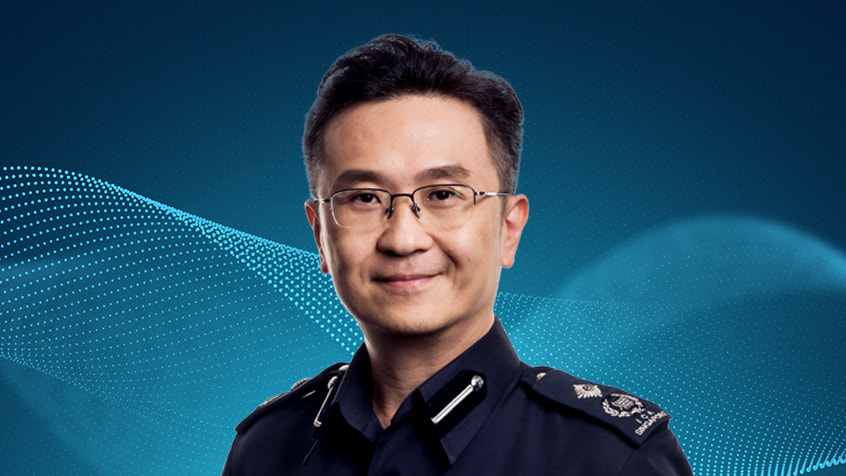
AC Chia Hoi Mun
AC Chia Hoi Mun has been in service for 23 years. He was formerly a Customs & Excise Department (CED) officer and joined ICA when CED merged with Singapore Immigration & Registration (SIR) in 2003. He has seen ICA in its early years, including the transition that saw officers from diverse organisational backgrounds work together.
“9/11 was the driving force for the merger of checkpoint operations of CED and SIR. There was an overall relook at how border control was carried out for persons, cargo and conveyances, to ensure security procedures were better coordinated and under the care of one single agency.”
AC Chia is currently Commander Coastal, overseeing border security and immigration operations at sea checkpoints such as Marina Bay Cruise Centre Singapore and Singapore Cruise Centre.
AC Chia Hoi Mun has been in service for 23 years. He was formerly a Customs & Excise Department (CED) officer and joined ICA when CED merged with Singapore Immigration & Registration (SIR) in 2003. He has seen ICA in its early years, including the transition that saw officers from diverse organisational backgrounds work together.
“9/11 was the driving force for the merger of checkpoint operations of CED and SIR. There was an overall relook at how border control was carried out for persons, cargo and conveyances, to ensure security procedures were better coordinated and under the care of one single agency.”
AC Chia is currently Commander Coastal, overseeing border security and immigration operations at sea checkpoints such as Marina Bay Cruise Centre Singapore and Singapore Cruise Centre.
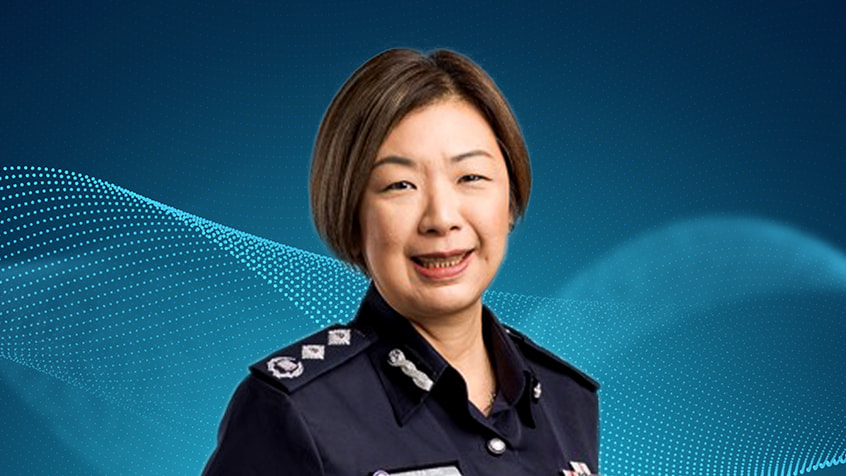
SAC Julia Sng
Domain Commander (Air) Julia, who currently oversees Airport and Air Cargo Commands, became the first female Commander of a checkpoint and held several key appointments including Deputy Director (Policy) and Director (Corporate Communications Division) earlier in her career. She played a central role in coordinating with various agencies and stakeholders for the completion of the Marina Bay Cruise Centre.
She believes that equal opportunities are given to all officers at ICA, regardless of gender, to undertake a spectrum of roles in identification and border security. This meritocratic approach to staff development ensures that ICA officers can look forward to an aspiring career.
Domain Commander (Air) Julia, who currently oversees Airport and Air Cargo Commands, became the first female Commander of a checkpoint and held several key appointments including Deputy Director (Policy) and Director (Corporate Communications Division) earlier in her career. She played a central role in coordinating with various agencies and stakeholders for the completion of the Marina Bay Cruise Centre.
She believes that equal opportunities are given to all officers at ICA, regardless of gender, to undertake a spectrum of roles in identification and border security. This meritocratic approach to staff development ensures that ICA officers can look forward to an aspiring career.
.jpg?sfvrsn=9d85e8e6_2)
AC (Ret.) Lee-Ho Sow Heng
AC (Ret.) Lee-Ho Sow Heng was the first female Senior Officer in the then-Immigration Department who rose up the ranks to become the Director for Policy Administration & International Affairs in ICA. When the organisation was mainly dominated by males, she never felt lesser than her male counterparts.
On 1 April 2003, when Singapore Immigration & Registration merged with the checkpoint operations arm of the Customs & Excise Department to form the Immigration & Checkpoints Authority, Mrs Lee was tasked with the responsibility to garner the loyalty of officers for the new organisation and get them to embrace a new working environment and responsibilities.
Soon after the merger, ICA faced the sudden outbreak of SARS. Officers realised they had more hands together working towards a common goal. Mrs Lee recounted that “SARS, ironically, helped us to really bind together.”
AC (Ret.) Lee-Ho Sow Heng was the first female Senior Officer in the then-Immigration Department who rose up the ranks to become the Director for Policy Administration & International Affairs in ICA. When the organisation was mainly dominated by males, she never felt lesser than her male counterparts.
On 1 April 2003, when Singapore Immigration & Registration merged with the checkpoint operations arm of the Customs & Excise Department to form the Immigration & Checkpoints Authority, Mrs Lee was tasked with the responsibility to garner the loyalty of officers for the new organisation and get them to embrace a new working environment and responsibilities.
Soon after the merger, ICA faced the sudden outbreak of SARS. Officers realised they had more hands together working towards a common goal. Mrs Lee recounted that “SARS, ironically, helped us to really bind together.”
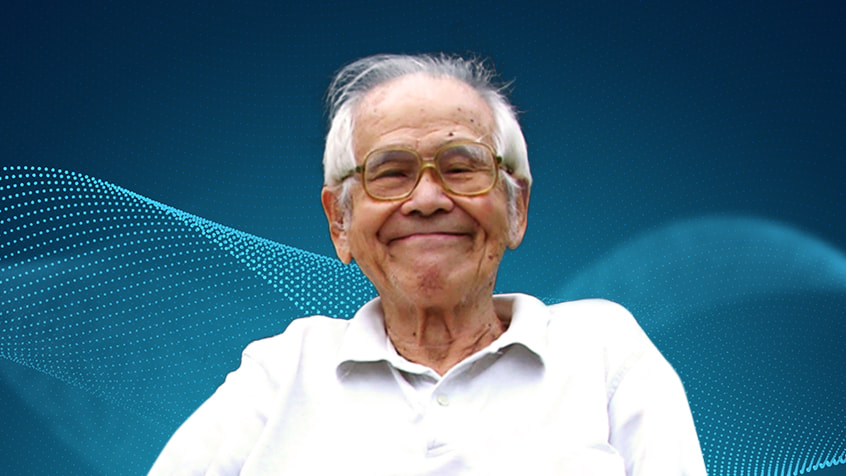
Late Mr Lim Joo Hock
The late Mr Lim Joo Hock was the first local Acting Controller of Immigration. He joined the Civil Service in Singapore as Inspector of Immigration in 1949, later appointed as Assistant Controller of Immigration in 1952 and then became the Acting Controller.
Back then, the Immigration Department held its main office at Havelock Road, where there were sections for the issue of passports, visas, Entry and Re-Entry Permits. His earliest work environment in Immigration included being headed by an expatriate officer, with three other expatriate Assistant Controllers of Immigration working alongside a Deputy Controller of Immigration.
In 1967, with the British withdrawal from Singapore and the successive departures of the five senior expatriate officers, he became the first local Acting Controller of Immigration. One of his many initiatives he took charge as Acting Controller was to improve the image of the Immigration Department in relation to their dealings with the public.
The late Mr Lim Joo Hock was the first local Acting Controller of Immigration. He joined the Civil Service in Singapore as Inspector of Immigration in 1949, later appointed as Assistant Controller of Immigration in 1952 and then became the Acting Controller.
Back then, the Immigration Department held its main office at Havelock Road, where there were sections for the issue of passports, visas, Entry and Re-Entry Permits. His earliest work environment in Immigration included being headed by an expatriate officer, with three other expatriate Assistant Controllers of Immigration working alongside a Deputy Controller of Immigration.
In 1967, with the British withdrawal from Singapore and the successive departures of the five senior expatriate officers, he became the first local Acting Controller of Immigration. One of his many initiatives he took charge as Acting Controller was to improve the image of the Immigration Department in relation to their dealings with the public.
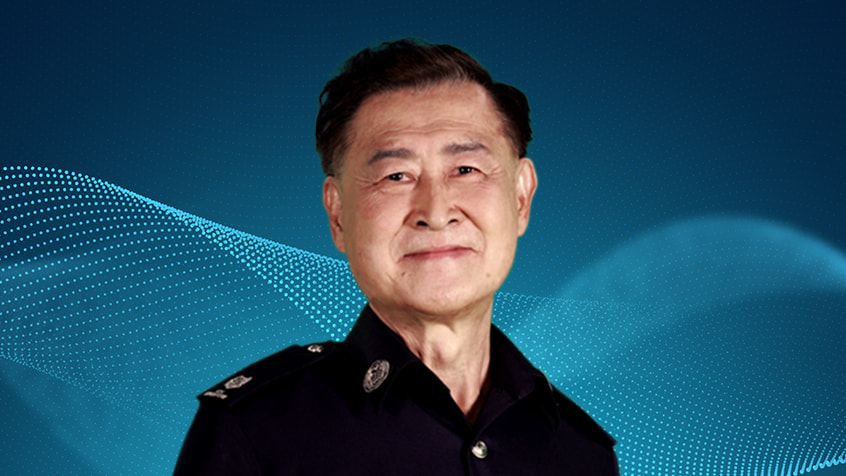
ASP Lim Kian Beng
ASP Lim Kian Beng was only 21 years old when he started his career with Singapore Immigration (SI) in 1977. In over 43 years of service, he has witnessed the evolution of the immigration landscape in Singapore and has been involved in various ICA milestones.
ASP Lim was heavily involved in the opening of Tuas Checkpoint in 1998 and Jurong Port Main Gate (JPMG) in 2008. He dealt with the administrative and logistical set-up of these places, including the set-up of the Blacklist Record Section.
One of ASP Lim’s most memorable incidents during his time at JPMG was the Mas Selamat incident. ASP Lim and his team were on high alert. “Every person, regardless of gender, entering JPMG was subjected to thorough checks. Similarly, all conveyances entering JPMG were subjected to thorough examinations to prevent possible concealment that might lead to his escape out of Singapore,” ASP Lim recalled.
ASP Lim Kian Beng was only 21 years old when he started his career with Singapore Immigration (SI) in 1977. In over 43 years of service, he has witnessed the evolution of the immigration landscape in Singapore and has been involved in various ICA milestones.
ASP Lim was heavily involved in the opening of Tuas Checkpoint in 1998 and Jurong Port Main Gate (JPMG) in 2008. He dealt with the administrative and logistical set-up of these places, including the set-up of the Blacklist Record Section.
One of ASP Lim’s most memorable incidents during his time at JPMG was the Mas Selamat incident. ASP Lim and his team were on high alert. “Every person, regardless of gender, entering JPMG was subjected to thorough checks. Similarly, all conveyances entering JPMG were subjected to thorough examinations to prevent possible concealment that might lead to his escape out of Singapore,” ASP Lim recalled.
-mohd-anwar-bin-abdullah-@-teo-ah-hock.jpg?sfvrsn=67f73b8d_2)
CI (Ret.) Mohd Anwar bin Abdullah @ Teo Ah Hock
CI (Ret.) Mohd Anwar joined the Immigration Department in 1967, retired as a Senior Checkpoint Inspector at Airport Command in September 2008, and was then re-employed at the Air Cargo and Airport Command until 2013. Throughout his service, he carried out a variety of difficult tasks, which are emblematic of Singapore in its formative years.
His first posting at Telok Ayer Basin at Prince Edward Road tasked him to handle barter traders and coolies, as well as requiring him to climb up tankers with a rope ladder. Later during his posting to Woodlands Checkpoint, he performed car clearance duties with just a table (as there was no booth) and grappled with the heat and fumes from the endless vehicles.
One of his more memorable experiences was during his posting in Intelligence in 1974, where he handled a case of illegal immigrants who armed themselves with concealed parangs or axes. On another occasion, he encountered a man holding a spear. Fortunately, he did not attack the officers.
CI (Ret.) Mohd Anwar joined the Immigration Department in 1967, retired as a Senior Checkpoint Inspector at Airport Command in September 2008, and was then re-employed at the Air Cargo and Airport Command until 2013. Throughout his service, he carried out a variety of difficult tasks, which are emblematic of Singapore in its formative years.
His first posting at Telok Ayer Basin at Prince Edward Road tasked him to handle barter traders and coolies, as well as requiring him to climb up tankers with a rope ladder. Later during his posting to Woodlands Checkpoint, he performed car clearance duties with just a table (as there was no booth) and grappled with the heat and fumes from the endless vehicles.
One of his more memorable experiences was during his posting in Intelligence in 1974, where he handled a case of illegal immigrants who armed themselves with concealed parangs or axes. On another occasion, he encountered a man holding a spear. Fortunately, he did not attack the officers.
-mohamed-ismail-ameer-batcha.jpg?sfvrsn=e7608695_2)
ASP (Ret.) Mohamed Ismail Ameer Batcha
He joined the Immigration Department in 1966 as a Junior Officer and retired in 2008 after 42 years of service. The call of duty frequently took him out to sea as a younger officer. He recalled officers had to jump from the gangway when inspecting ships and climb tankers with their bags of immigration stamps, which sometimes dropped into the sea. "You had to be very alert that you don't fall yourself. I remember quite a few officers fell in, and one had to be saved by an American sailor."
ASP (Ret.) Mohd Ismail continued to study part-time and upgrade his qualifications. He was one of the first two Junior Officers to enter the Senior Officer scheme in 1984, marking a human resources milestone that was covered by the newspapers.
He joined the Immigration Department in 1966 as a Junior Officer and retired in 2008 after 42 years of service. The call of duty frequently took him out to sea as a younger officer. He recalled officers had to jump from the gangway when inspecting ships and climb tankers with their bags of immigration stamps, which sometimes dropped into the sea. "You had to be very alert that you don't fall yourself. I remember quite a few officers fell in, and one had to be saved by an American sailor."
ASP (Ret.) Mohd Ismail continued to study part-time and upgrade his qualifications. He was one of the first two Junior Officers to enter the Senior Officer scheme in 1984, marking a human resources milestone that was covered by the newspapers.
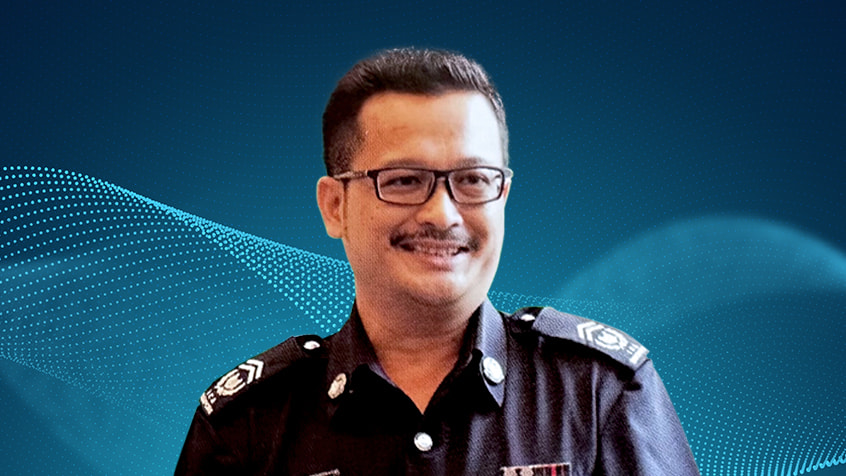
CI (2) Md Jalalludin Bin Juki
Seconded to the Singapore Consulate in Chennai, India, from 1999 to 2001, CI (2) Md Jalalludin's fondest memories of the job was going out of his way to help others. One of these was in helping a Singaporean family in the repatriation of a deceased family member within 24 hours of his passing.
CI (2) Md Jalalludin had the chance to be the first ICA Specialist to be posted to the Singapore mission in Yangon, Myanmar, in 2011. His job was to receive and process visa applications for Myanmar and other foreign nationals who required a visa to visit Singapore, as well as providing immigration and consular assistance to Singaporeans in distress.
While in Myanmar, he also had the chance to be part of an ASEAN observation team during Myanmar's by-elections in 2012 and to be the Singapore Embassy's representative to ensure the national sailing team's security during the SEA Games in Myanmar in 2013.
Seconded to the Singapore Consulate in Chennai, India, from 1999 to 2001, CI (2) Md Jalalludin's fondest memories of the job was going out of his way to help others. One of these was in helping a Singaporean family in the repatriation of a deceased family member within 24 hours of his passing.
CI (2) Md Jalalludin had the chance to be the first ICA Specialist to be posted to the Singapore mission in Yangon, Myanmar, in 2011. His job was to receive and process visa applications for Myanmar and other foreign nationals who required a visa to visit Singapore, as well as providing immigration and consular assistance to Singaporeans in distress.
While in Myanmar, he also had the chance to be part of an ASEAN observation team during Myanmar's by-elections in 2012 and to be the Singapore Embassy's representative to ensure the national sailing team's security during the SEA Games in Myanmar in 2013.
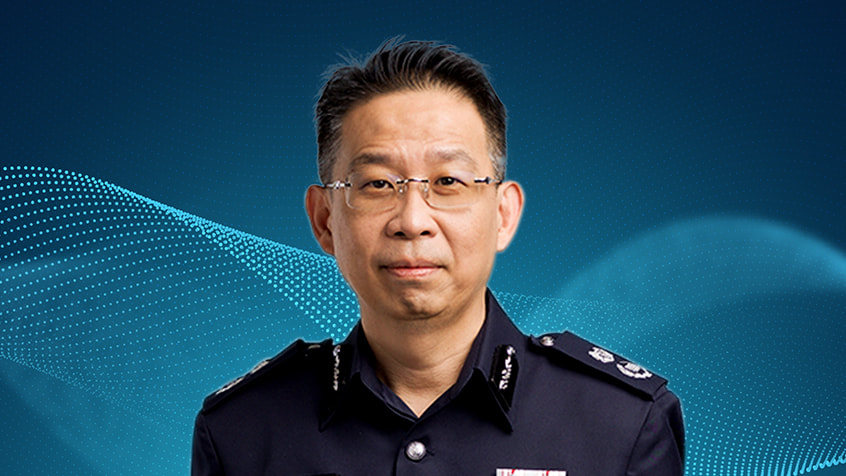
Deputy Commissioner Ong Choon Beng
Deputy Commissioner (DC) Ong Choon Beng was the first Land Domain Commander for the Integrated Checkpoints Command (ICC), a new structure of organising command of Home Team forces at the checkpoints according to Land, Sea and Air Domains.
Being the first Domain to start the ICC, DC Ong shared "There was no roadmap to follow or well-trodden path for us to take. We had to blaze a trail and chart our own way based on what we felt would be best for our Domain and our officers, anchored by our experience and our instincts."
DC Ong currently oversees ICA’s capability and technology development.
Deputy Commissioner (DC) Ong Choon Beng was the first Land Domain Commander for the Integrated Checkpoints Command (ICC), a new structure of organising command of Home Team forces at the checkpoints according to Land, Sea and Air Domains.
Being the first Domain to start the ICC, DC Ong shared "There was no roadmap to follow or well-trodden path for us to take. We had to blaze a trail and chart our own way based on what we felt would be best for our Domain and our officers, anchored by our experience and our instincts."
DC Ong currently oversees ICA’s capability and technology development.
-quek-kian-beng.jpg?sfvrsn=fd8b9a12_2)
INSP (Ret.) Quek Kian Beng
Beginning as an immigration officer in 1975 and moving up the ranks, INSP (Ret.) Quek Kian Beng retired from the Immigration Department in 2022 as an Inspector in Tuas Command. He had accumulated a wealth of knowledge over the years in immigration, enforcement, and overseas mission operations.
Between 1999 and 2002, Inspector Quek was posted to Dhaka, Bangladesh as a Visa Consular officer. Along with overcoming the language barrier, he had to acclimate quickly to a completely new way of life, including a new culture and practices. He recalled that the water from the tap was muddy and also experienced frequent electricity blackouts that needed him to have candles around his apartment. At that time, having clean and accessible meals was also difficult. “I began to appreciate the comfortable life in Singapore and thought of how fortunate we have been to have grown up and lived in Singapore,” he said of those times.
Beginning as an immigration officer in 1975 and moving up the ranks, INSP (Ret.) Quek Kian Beng retired from the Immigration Department in 2022 as an Inspector in Tuas Command. He had accumulated a wealth of knowledge over the years in immigration, enforcement, and overseas mission operations.
Between 1999 and 2002, Inspector Quek was posted to Dhaka, Bangladesh as a Visa Consular officer. Along with overcoming the language barrier, he had to acclimate quickly to a completely new way of life, including a new culture and practices. He recalled that the water from the tap was muddy and also experienced frequent electricity blackouts that needed him to have candles around his apartment. At that time, having clean and accessible meals was also difficult. “I began to appreciate the comfortable life in Singapore and thought of how fortunate we have been to have grown up and lived in Singapore,” he said of those times.
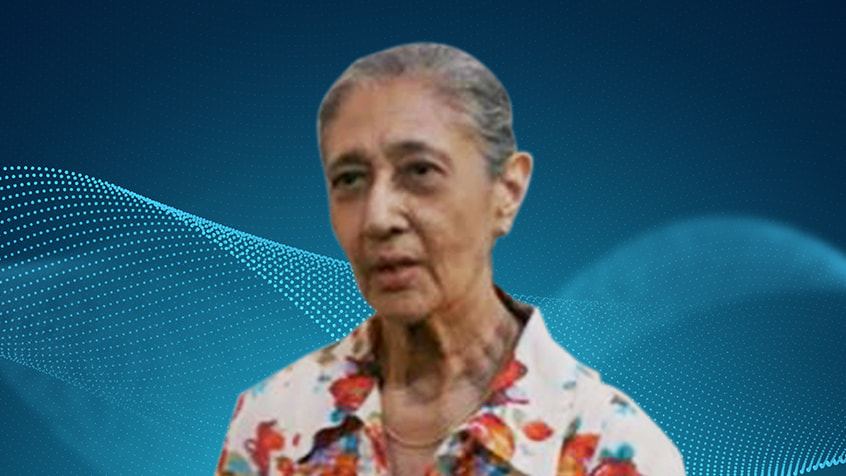
Mrs Rattanjeet Kaur D/O Khem Singh (Ret.)
When Singapore gained independence in 1965, immigration and border control became an integral part of our nation-building efforts. New identity documents, with their iconic red colour established our distinct identity as Singaporeans.
“The work of the National Registration Department (NRD) improved vastly with computerisation. This improved accuracy in tracking and verifying information. Before that, registration records were captured with pen and paper. We needed to have good handwriting to ensure names and other important information were clearly written on IC and Birth Certificates," shared Mrs Rattanjeet who started her career with NRD and has been in service for 53 years.
When Singapore gained independence in 1965, immigration and border control became an integral part of our nation-building efforts. New identity documents, with their iconic red colour established our distinct identity as Singaporeans.
“The work of the National Registration Department (NRD) improved vastly with computerisation. This improved accuracy in tracking and verifying information. Before that, registration records were captured with pen and paper. We needed to have good handwriting to ensure names and other important information were clearly written on IC and Birth Certificates," shared Mrs Rattanjeet who started her career with NRD and has been in service for 53 years.
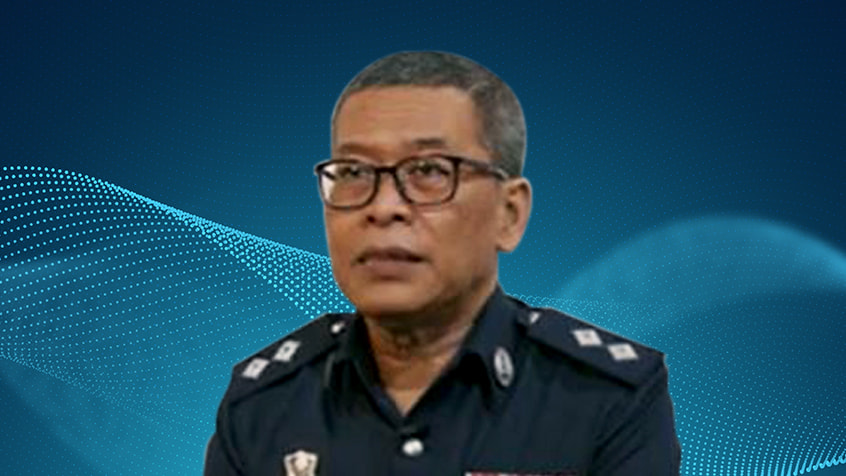
INSP Sharif Bin Ahmad
With 41 years of service, INSP Sharif started his career with the Customs & Excise Department (CED). "CED and SIR were two agencies with different mandates and officers performing different functions. The merger seemed impossible then. But the terror threat was very real. SIR and CED officers focused on the task on hand to keep Singapore safe and secure. The impossible became a reality and ICA was formed on 1 Apr 2003."
In his years of service, Sharif was involved in many intelligence-led operations that resulted in the successful detection of contraband and controlled/prohibited items. He is now posted as a Trainer at Training Command.
With 41 years of service, INSP Sharif started his career with the Customs & Excise Department (CED). "CED and SIR were two agencies with different mandates and officers performing different functions. The merger seemed impossible then. But the terror threat was very real. SIR and CED officers focused on the task on hand to keep Singapore safe and secure. The impossible became a reality and ICA was formed on 1 Apr 2003."
In his years of service, Sharif was involved in many intelligence-led operations that resulted in the successful detection of contraband and controlled/prohibited items. He is now posted as a Trainer at Training Command.
Managing Unprecedented Crises
2003
2020
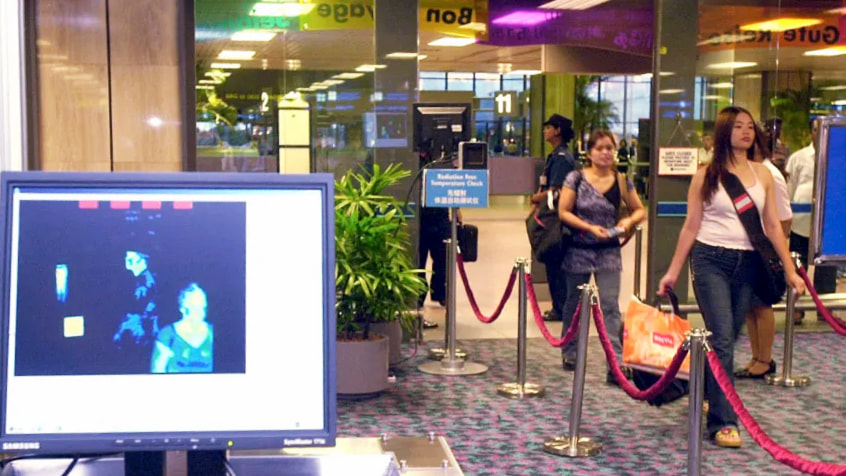
2003 - Severe Acute Respiratory Syndrome (SARS)
“Just days after merger, the [officers of the] former SIR and CED were put to its first test – to take on the common challenge of SARS as ICA officers.”
– SUPT Lim-Yeo Hwee Meng, One Journey, One Heartbeat
The SARS pandemic had a significant impact on Singapore. As part of ICA's efforts to strengthen border control measures at checkpoints, ICA worked closely with homefront agencies and our international counterparts. It became the first country to adopt the Infrared Fever Sensing System (IFSS) to conduct mass health screening of travellers at air and sea checkpoints to detect febrile travellers. Land checkpoints adopted TempaDOT temperature strips at the vehicle clearance zones to determine if a traveller was having a fever. Singapore was removed from the World Health Organisation’s list of areas with local SARS transmission on 30 May 2003.
“Just days after merger, the [officers of the] former SIR and CED were put to its first test – to take on the common challenge of SARS as ICA officers.”
– SUPT Lim-Yeo Hwee Meng, One Journey, One Heartbeat
The SARS pandemic had a significant impact on Singapore. As part of ICA's efforts to strengthen border control measures at checkpoints, ICA worked closely with homefront agencies and our international counterparts. It became the first country to adopt the Infrared Fever Sensing System (IFSS) to conduct mass health screening of travellers at air and sea checkpoints to detect febrile travellers. Land checkpoints adopted TempaDOT temperature strips at the vehicle clearance zones to determine if a traveller was having a fever. Singapore was removed from the World Health Organisation’s list of areas with local SARS transmission on 30 May 2003.
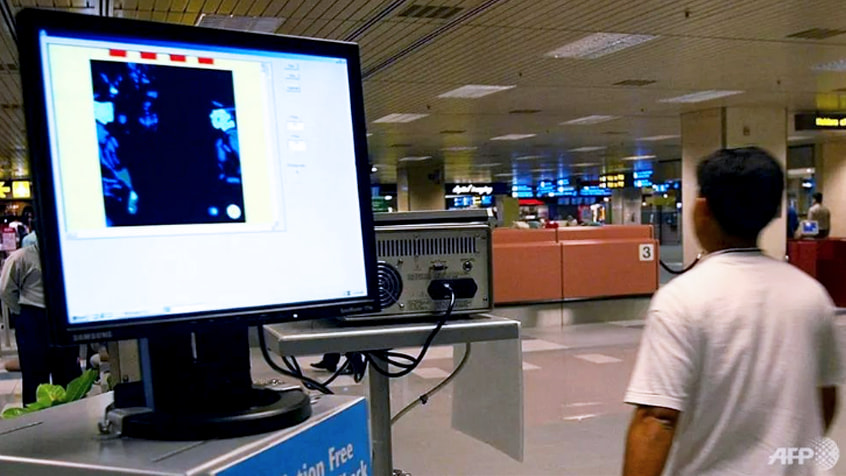
2003 - Severe Acute Respiratory Syndrome (SARS)
“Just days after merger, the [officers of the] former SIR and CED were put to its first test – to take on the common challenge of SARS as ICA officers.”
– SUPT Lim-Yeo Hwee Meng, One Journey, One Heartbeat
The SARS pandemic had a significant impact on Singapore. As part of ICA's efforts to strengthen border control measures at checkpoints, ICA worked closely with homefront agencies and our international counterparts. It became the first country to adopt the Infrared Fever Sensing System (IFSS) to conduct mass health screening of travellers at air and sea checkpoints to detect febrile travellers. Land checkpoints adopted TempaDOT temperature strips at the vehicle clearance zones to determine if a traveller was having a fever. Singapore was removed from the World Health Organisation’s list of areas with local SARS transmission on 30 May 2003.
“Just days after merger, the [officers of the] former SIR and CED were put to its first test – to take on the common challenge of SARS as ICA officers.”
– SUPT Lim-Yeo Hwee Meng, One Journey, One Heartbeat
The SARS pandemic had a significant impact on Singapore. As part of ICA's efforts to strengthen border control measures at checkpoints, ICA worked closely with homefront agencies and our international counterparts. It became the first country to adopt the Infrared Fever Sensing System (IFSS) to conduct mass health screening of travellers at air and sea checkpoints to detect febrile travellers. Land checkpoints adopted TempaDOT temperature strips at the vehicle clearance zones to determine if a traveller was having a fever. Singapore was removed from the World Health Organisation’s list of areas with local SARS transmission on 30 May 2003.
2020 - COVID-19 pandemic
When COVID-19 struck, ICA tightened Singapore's border control measures and constantly adjusted them to mitigate the evolving situation. On 23 March, Singapore made the unprecedented move to close its borders to all short-term visits. In anticipation of a protracted fight against COVID-19, ICA leveraged technology and fine-tuned its operational processes to alleviate frontline officers' workload. ICA also implemented and enforced the Stay-Home Notice (SHN) regime to minimise the risk of community spread from returning residents.
Among the first few organisations in the world to introduce the Electronic Tag Monitoring System (ETMS), ICA enhanced travellers' compliance with the SHN regime and thereby reduced the risk of COVID-19 transmission to the local community.
ICA set up the Safe Travel Office (STO) in August to coordinate travel applications under the various International Safe Travel schemes as borders gradually reopened. As the main public gateway, STO provided greater convenience to travellers by serving as a single touchpoint for their entry applications, regardless of their travel scheme and purpose of entry.
Singapore reopened its borders to all fully vaccinated travellers, removing all existing vaccinated travel lanes (VTL) and unilateral opening arrangements from 1 April 2022.
When COVID-19 struck, ICA tightened Singapore's border control measures and constantly adjusted them to mitigate the evolving situation. On 23 March, Singapore made the unprecedented move to close its borders to all short-term visits. In anticipation of a protracted fight against COVID-19, ICA leveraged technology and fine-tuned its operational processes to alleviate frontline officers' workload. ICA also implemented and enforced the Stay-Home Notice (SHN) regime to minimise the risk of community spread from returning residents.
Among the first few organisations in the world to introduce the Electronic Tag Monitoring System (ETMS), ICA enhanced travellers' compliance with the SHN regime and thereby reduced the risk of COVID-19 transmission to the local community.
ICA set up the Safe Travel Office (STO) in August to coordinate travel applications under the various International Safe Travel schemes as borders gradually reopened. As the main public gateway, STO provided greater convenience to travellers by serving as a single touchpoint for their entry applications, regardless of their travel scheme and purpose of entry.
Singapore reopened its borders to all fully vaccinated travellers, removing all existing vaccinated travel lanes (VTL) and unilateral opening arrangements from 1 April 2022.
.jpg?sfvrsn=b865711e_2)
2020 - COVID-19 pandemic
When COVID-19 struck, ICA tightened Singapore's border control measures and constantly adjusted them to mitigate the evolving situation. On 23 March, Singapore made the unprecedented move to close its borders to all short-term visits. In anticipation of a protracted fight against COVID-19, ICA leveraged technology and fine-tuned its operational processes to alleviate frontline officers' workload. ICA also implemented and enforced the Stay-Home Notice (SHN) regime to minimise the risk of community spread from returning residents.
Among the first few organisations in the world to introduce the Electronic Tag Monitoring System (ETMS), ICA enhanced travellers' compliance with the SHN regime and thereby reduced the risk of COVID-19 transmission to the local community.
ICA set up the Safe Travel Office (STO) in August to coordinate travel applications under the various International Safe Travel schemes as borders gradually reopened. As the main public gateway, STO provided greater convenience to travellers by serving as a single touchpoint for their entry applications, regardless of their travel scheme and purpose of entry.
Singapore reopened its borders to all fully vaccinated travellers, removing all existing vaccinated travel lanes (VTL) and unilateral opening arrangements from 1 April 2022.
When COVID-19 struck, ICA tightened Singapore's border control measures and constantly adjusted them to mitigate the evolving situation. On 23 March, Singapore made the unprecedented move to close its borders to all short-term visits. In anticipation of a protracted fight against COVID-19, ICA leveraged technology and fine-tuned its operational processes to alleviate frontline officers' workload. ICA also implemented and enforced the Stay-Home Notice (SHN) regime to minimise the risk of community spread from returning residents.
Among the first few organisations in the world to introduce the Electronic Tag Monitoring System (ETMS), ICA enhanced travellers' compliance with the SHN regime and thereby reduced the risk of COVID-19 transmission to the local community.
ICA set up the Safe Travel Office (STO) in August to coordinate travel applications under the various International Safe Travel schemes as borders gradually reopened. As the main public gateway, STO provided greater convenience to travellers by serving as a single touchpoint for their entry applications, regardless of their travel scheme and purpose of entry.
Singapore reopened its borders to all fully vaccinated travellers, removing all existing vaccinated travel lanes (VTL) and unilateral opening arrangements from 1 April 2022.
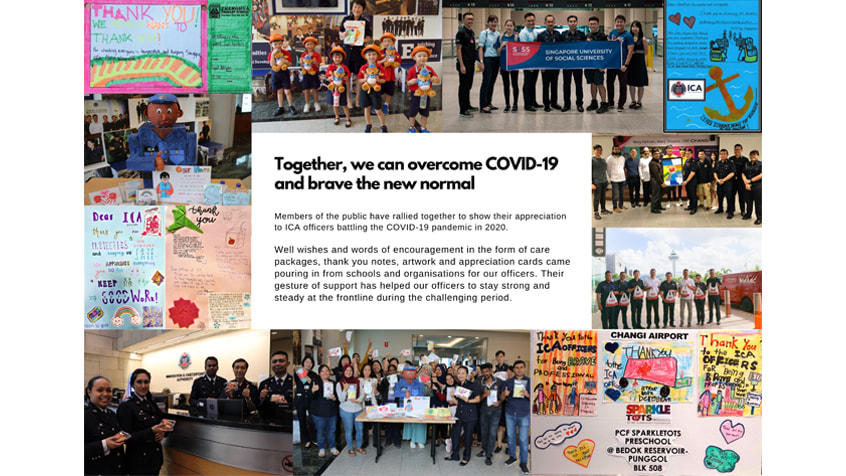
2020 - COVID-19 pandemic
When COVID-19 struck, ICA tightened Singapore's border control measures and constantly adjusted them to mitigate the evolving situation. On 23 March, Singapore made the unprecedented move to close its borders to all short-term visits. In anticipation of a protracted fight against COVID-19, ICA leveraged technology and fine-tuned its operational processes to alleviate frontline officers' workload. ICA also implemented and enforced the Stay-Home Notice (SHN) regime to minimise the risk of community spread from returning residents.
Among the first few organisations in the world to introduce the Electronic Tag Monitoring System (ETMS), ICA enhanced travellers' compliance with the SHN regime and thereby reduced the risk of COVID-19 transmission to the local community.
ICA set up the Safe Travel Office (STO) in August to coordinate travel applications under the various International Safe Travel schemes as borders gradually reopened. As the main public gateway, STO provided greater convenience to travellers by serving as a single touchpoint for their entry applications, regardless of their travel scheme and purpose of entry.
Singapore reopened its borders to all fully vaccinated travellers, removing all existing vaccinated travel lanes (VTL) and unilateral opening arrangements from 1 April 2022.
When COVID-19 struck, ICA tightened Singapore's border control measures and constantly adjusted them to mitigate the evolving situation. On 23 March, Singapore made the unprecedented move to close its borders to all short-term visits. In anticipation of a protracted fight against COVID-19, ICA leveraged technology and fine-tuned its operational processes to alleviate frontline officers' workload. ICA also implemented and enforced the Stay-Home Notice (SHN) regime to minimise the risk of community spread from returning residents.
Among the first few organisations in the world to introduce the Electronic Tag Monitoring System (ETMS), ICA enhanced travellers' compliance with the SHN regime and thereby reduced the risk of COVID-19 transmission to the local community.
ICA set up the Safe Travel Office (STO) in August to coordinate travel applications under the various International Safe Travel schemes as borders gradually reopened. As the main public gateway, STO provided greater convenience to travellers by serving as a single touchpoint for their entry applications, regardless of their travel scheme and purpose of entry.
Singapore reopened its borders to all fully vaccinated travellers, removing all existing vaccinated travel lanes (VTL) and unilateral opening arrangements from 1 April 2022.
.jpg?sfvrsn=4727229a_2)
2020 - COVID-19 pandemic
When COVID-19 struck, ICA tightened Singapore's border control measures and constantly adjusted them to mitigate the evolving situation. On 23 March, Singapore made the unprecedented move to close its borders to all short-term visits. In anticipation of a protracted fight against COVID-19, ICA leveraged technology and fine-tuned its operational processes to alleviate frontline officers' workload. ICA also implemented and enforced the Stay-Home Notice (SHN) regime to minimise the risk of community spread from returning residents.
Among the first few organisations in the world to introduce the Electronic Tag Monitoring System (ETMS), ICA enhanced travellers' compliance with the SHN regime and thereby reduced the risk of COVID-19 transmission to the local community.
ICA set up the Safe Travel Office (STO) in August to coordinate travel applications under the various International Safe Travel schemes as borders gradually reopened. As the main public gateway, STO provided greater convenience to travellers by serving as a single touchpoint for their entry applications, regardless of their travel scheme and purpose of entry.
Singapore reopened its borders to all fully vaccinated travellers, removing all existing vaccinated travel lanes (VTL) and unilateral opening arrangements from 1 April 2022.
When COVID-19 struck, ICA tightened Singapore's border control measures and constantly adjusted them to mitigate the evolving situation. On 23 March, Singapore made the unprecedented move to close its borders to all short-term visits. In anticipation of a protracted fight against COVID-19, ICA leveraged technology and fine-tuned its operational processes to alleviate frontline officers' workload. ICA also implemented and enforced the Stay-Home Notice (SHN) regime to minimise the risk of community spread from returning residents.
Among the first few organisations in the world to introduce the Electronic Tag Monitoring System (ETMS), ICA enhanced travellers' compliance with the SHN regime and thereby reduced the risk of COVID-19 transmission to the local community.
ICA set up the Safe Travel Office (STO) in August to coordinate travel applications under the various International Safe Travel schemes as borders gradually reopened. As the main public gateway, STO provided greater convenience to travellers by serving as a single touchpoint for their entry applications, regardless of their travel scheme and purpose of entry.
Singapore reopened its borders to all fully vaccinated travellers, removing all existing vaccinated travel lanes (VTL) and unilateral opening arrangements from 1 April 2022.
Our Commissioners
2018 to Present
2010 to 2018
2005 to 2010
2003 to 2005
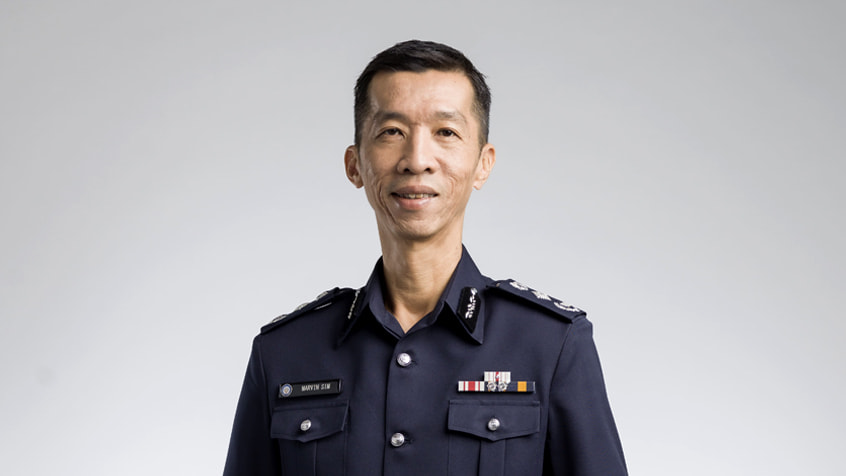
Commissioner of ICA, Mr Marvin Sim
Since taking over the role of Commissioner of ICA in 2018, Mr Marvin Sim has led ICA to make great progress in its transformation journey. These included implementing the New Clearance Concept at the checkpoints, taking over the protective security responsibilities from Singapore Police Force and embarking on the transformation of the ICA Services Centre.
He also led ICA during the COVID-19 pandemic, ensuring that ICA continued to fulfill its duty of keeping Singapore safe and connected to the world.
“Enhancing Operations Excellence and Capabilities calls on ICA to continue enhancing operational excellence at our checkpoints and services today, while innovating our concept of operations and systems to develop capabilities for future challenges.”
– Mr Marvin Sim, ICA Annual 2018
Since taking over the role of Commissioner of ICA in 2018, Mr Marvin Sim has led ICA to make great progress in its transformation journey. These included implementing the New Clearance Concept at the checkpoints, taking over the protective security responsibilities from Singapore Police Force and embarking on the transformation of the ICA Services Centre.
He also led ICA during the COVID-19 pandemic, ensuring that ICA continued to fulfill its duty of keeping Singapore safe and connected to the world.
“Enhancing Operations Excellence and Capabilities calls on ICA to continue enhancing operational excellence at our checkpoints and services today, while innovating our concept of operations and systems to develop capabilities for future challenges.”
– Mr Marvin Sim, ICA Annual 2018
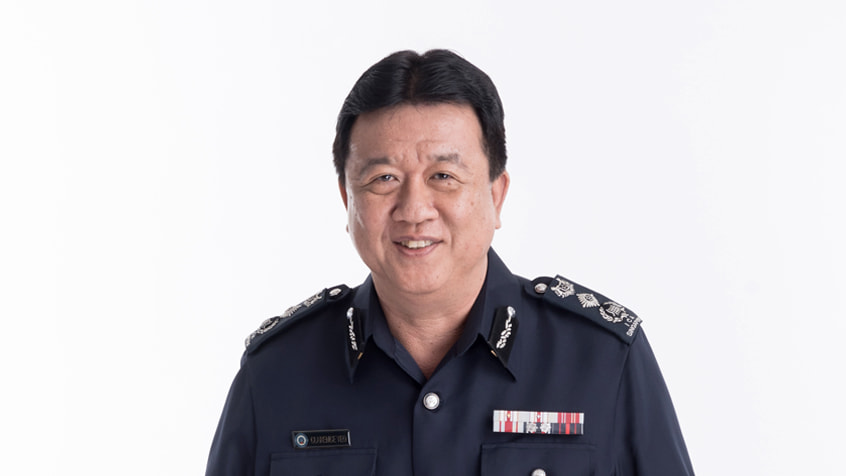
Former Commissioner of ICA, Mr Clarence Yeo
Mr Clarence Yeo helmed ICA from 2010 to 2018. He was the first home-grown ICA officer to have led ICA.
During his eight-year tenure as Commissioner, ICA was conferred the Singapore Quality Award with Special Commendation where at that time, only nine organisations had been accorded this prestigious recognition. ICA became a leader in border security and identification and was conferred with numerous accolades. Under his guidance, the Integrated Checkpoints Command concept, which strengthened the coordination among the Home Team agencies at the checkpoints under a unified command and control structure, was introduced in 2015.
“We must stay ahead of not just the enemy but also ourselves. This means that we must be better today than we were yesterday and that we will be better tomorrow, compared to today.”
– Mr Clarence Yeo, ICA Annual 2011
Mr Clarence Yeo helmed ICA from 2010 to 2018. He was the first home-grown ICA officer to have led ICA.
During his eight-year tenure as Commissioner, ICA was conferred the Singapore Quality Award with Special Commendation where at that time, only nine organisations had been accorded this prestigious recognition. ICA became a leader in border security and identification and was conferred with numerous accolades. Under his guidance, the Integrated Checkpoints Command concept, which strengthened the coordination among the Home Team agencies at the checkpoints under a unified command and control structure, was introduced in 2015.
“We must stay ahead of not just the enemy but also ourselves. This means that we must be better today than we were yesterday and that we will be better tomorrow, compared to today.”
– Mr Clarence Yeo, ICA Annual 2011
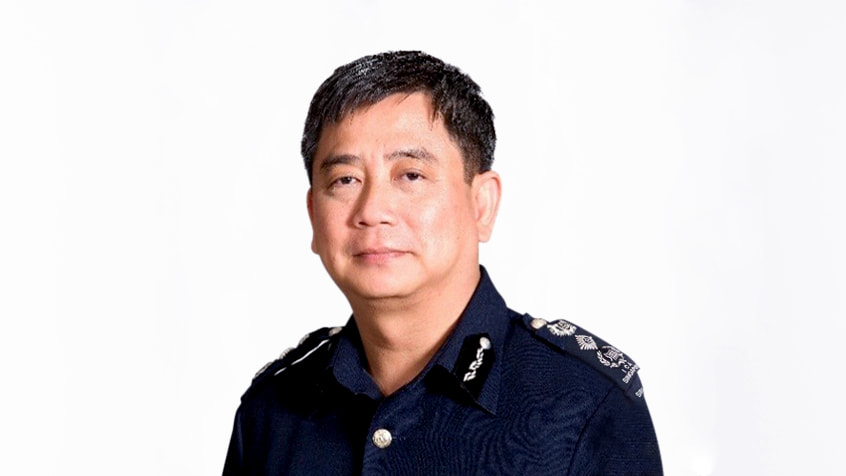
Former Commissioner of ICA, Mr Eric Tan
Mr Eric Tan helmed ICA from 2005 to 2010. Under his leadership, ICA established itself as a pioneer in border security and identification with the introduction of the biometric passport in August 2006 and the polycarbonate Long Term Pass card in September 2008. ICA successfully rolled out other innovative solutions such as the Biometric Identification of Motorbikers System (BIKES) in October 2006 and customer-centric initiatives such as e-VISA, which was launched in August 2008.
“ICA has broken new ground in redefining conventional wisdom, balancing the seemingly dichotomous twin objectives of security and service. In our quest to excel in both, we have become a trailblazer in the management of border security for others to emulate.”
– Mr Eric Tan, ICA Annual 2007
Mr Eric Tan helmed ICA from 2005 to 2010. Under his leadership, ICA established itself as a pioneer in border security and identification with the introduction of the biometric passport in August 2006 and the polycarbonate Long Term Pass card in September 2008. ICA successfully rolled out other innovative solutions such as the Biometric Identification of Motorbikers System (BIKES) in October 2006 and customer-centric initiatives such as e-VISA, which was launched in August 2008.
“ICA has broken new ground in redefining conventional wisdom, balancing the seemingly dichotomous twin objectives of security and service. In our quest to excel in both, we have become a trailblazer in the management of border security for others to emulate.”
– Mr Eric Tan, ICA Annual 2007
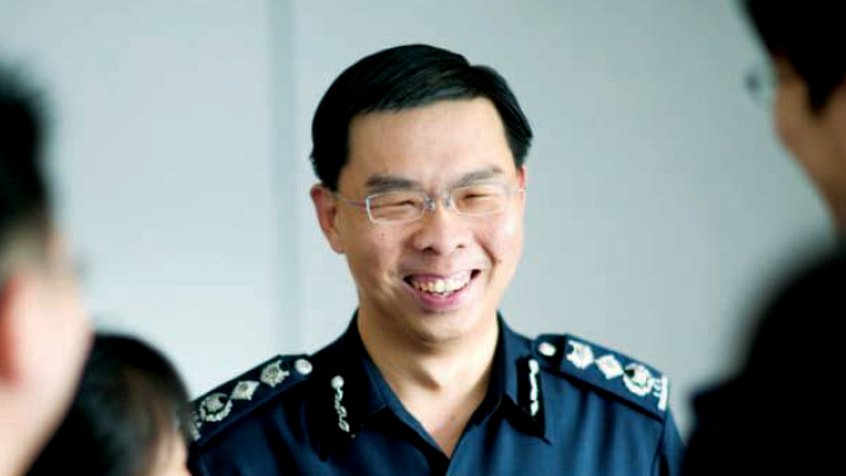
First Commissioner of ICA, Mr Lock Wai Han
Mr Lock Wai Han was the first Commissioner of ICA. He helmed ICA from 2003 to 2005.
Under his leadership, he oversaw the merger of ICA in 2003, led the organisation in the fight against terrorism and rallied officers in the fight against SARS. Despite the challenging security landscape, rising traveller volume and the increasing demands of customers, his leadership enabled ICA to overcome numerous challenges.
“With strength in unity and by tapping on each other’s wealth of experience, ICA can confidently take on the challenges of the future."
– Mr Lock Wai Han, WPS 2004
Mr Lock Wai Han was the first Commissioner of ICA. He helmed ICA from 2003 to 2005.
Under his leadership, he oversaw the merger of ICA in 2003, led the organisation in the fight against terrorism and rallied officers in the fight against SARS. Despite the challenging security landscape, rising traveller volume and the increasing demands of customers, his leadership enabled ICA to overcome numerous challenges.
“With strength in unity and by tapping on each other’s wealth of experience, ICA can confidently take on the challenges of the future."
– Mr Lock Wai Han, WPS 2004
Our Uniforms
1950s - 1980s
1995 - 1998
2003 - 2019
2021
2023

1957 Immigration Department
In its early years, officers adopted a more casual look, using a brown and cream design that made officers appear warm and approachable. This colour combination did not change for more than 20 years, although the styles were modified to keep up with changing trends.
Officers from the National Registration Department did not don uniform. However, they were required to dress professionally in their civilian outfit.
Officers from the National Registration Department did not don uniform. However, they were required to dress professionally in their civilian outfit.
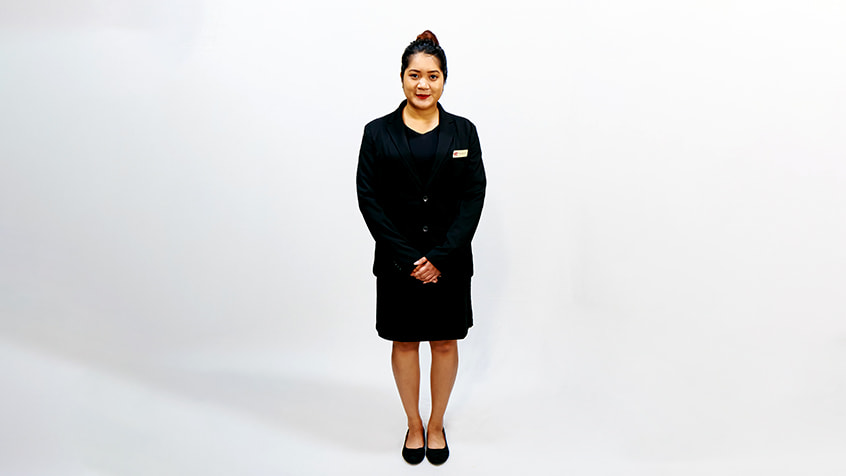
1981 National Registration Department
In its early years, officers adopted a more casual look, using a brown and cream design that made officers appear warm and approachable. This colour combination did not change for more than 20 years, although the styles were modified to keep up with changing trends.
Officers from the National Registration Department did not don uniform. However, they were required to dress professionally in their civilian outfit.
Officers from the National Registration Department did not don uniform. However, they were required to dress professionally in their civilian outfit.

1995 Singapore Immigration
New Immigration uniforms in soothing shades of green were introduced. The outfits looked more professional while keeping with the warm and friendly image. There were two styles: a formal uniform worn by officers at airports and a less formal uniform worn by field officers and officers at land and sea checkpoints.
Officers from the Customs & Excise Department wore blue uniforms before 1 April 2003.
Officers from the Customs & Excise Department wore blue uniforms before 1 April 2003.

1998 Singapore Immigration & Registration (female)
New Immigration uniforms in soothing shades of green were introduced. The outfits looked more professional while keeping with the warm and friendly image. There were two styles: a formal uniform worn by officers at airports and a less formal uniform worn by field officers and officers at land and sea checkpoints.
Officers from the Customs & Excise Department wore blue uniforms before 1 April 2003.
Officers from the Customs & Excise Department wore blue uniforms before 1 April 2003.

1998 Singapore Immigration & Registration (male)
New Immigration uniforms in soothing shades of green were introduced. The outfits looked more professional while keeping with the warm and friendly image. There were two styles: a formal uniform worn by officers at airports and a less formal uniform worn by field officers and officers at land and sea checkpoints.
Officers from the Customs & Excise Department wore blue uniforms before 1 April 2003.
Officers from the Customs & Excise Department wore blue uniforms before 1 April 2003.
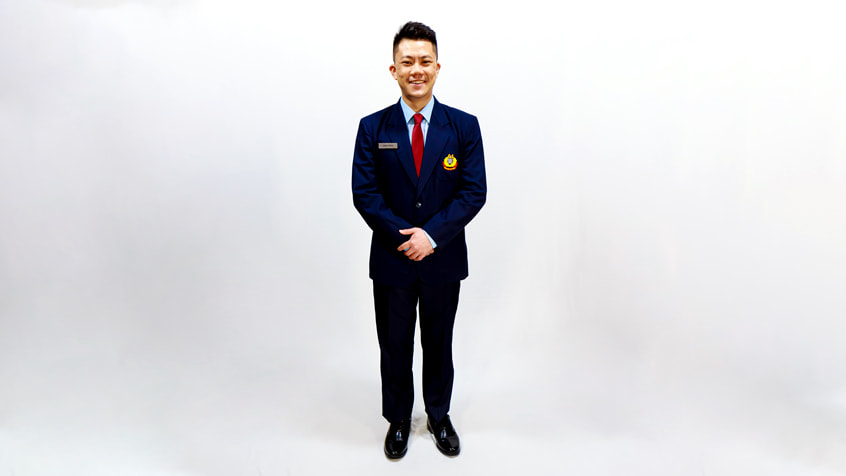
1998 Customs & Excise Department
New Immigration uniforms in soothing shades of green were introduced. The outfits looked more professional while keeping with the warm and friendly image. There were two styles: a formal uniform worn by officers at airports and a less formal uniform worn by field officers and officers at land and sea checkpoints.
Officers from the Customs & Excise Department wore blue uniforms before 1 April 2003.
Officers from the Customs & Excise Department wore blue uniforms before 1 April 2003.

2003 Immigration & Checkpoints Authority
With the merger of Singapore Immigration & Registration and the checkpoint operations of the Customs & Excise Department, it necessitated new uniforms. Navy blue was chosen to establish ICA as a member of the Home Team. The uniform came in different designs to suit the varied operating environments in which officers worked in.
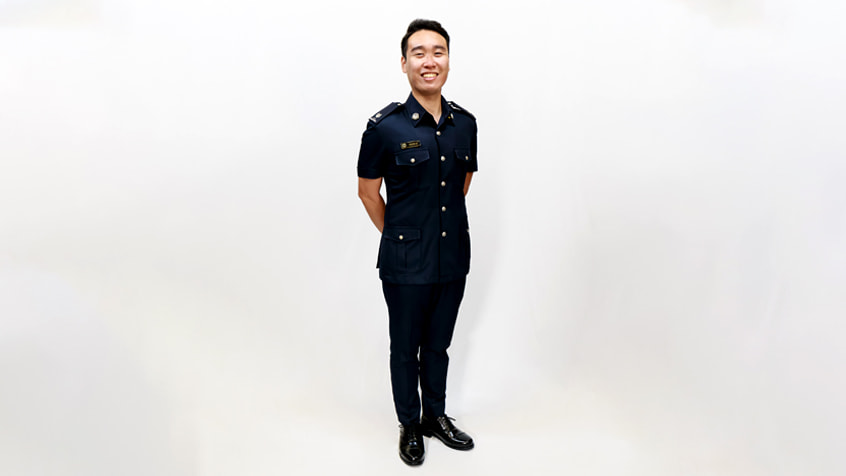
2003 Immigration & Checkpoints Authority
With the merger of Singapore Immigration & Registration and the checkpoint operations of the Customs & Excise Department, it necessitated new uniforms. Navy blue was chosen to establish ICA as a member of the Home Team. The uniform came in different designs to suit the varied operating environments in which officers worked in.
.jpg?sfvrsn=289bcaf6_2)
2005 Immigration & Checkpoints Authority (Services Centre Uniform)
With the merger of Singapore Immigration & Registration and the checkpoint operations of the Customs & Excise Department, it necessitated new uniforms. Navy blue was chosen to establish ICA as a member of the Home Team. The uniform came in different designs to suit the varied operating environments in which officers worked in.
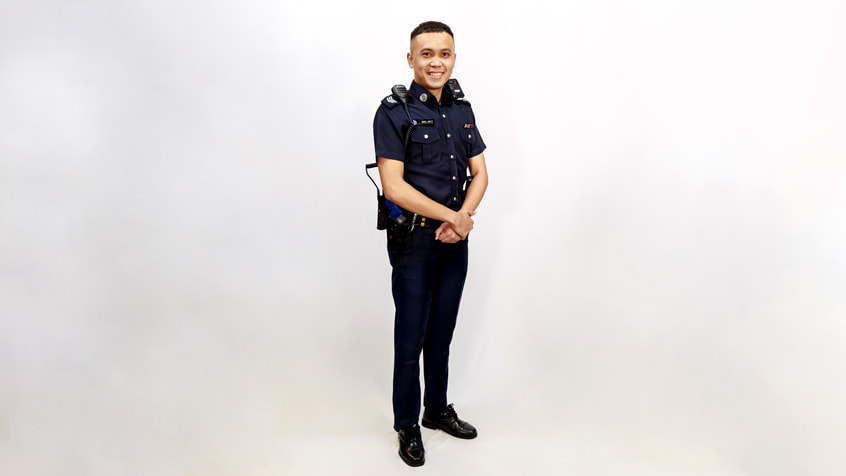
2019 Immigration & Checkpoints Authority
With the merger of Singapore Immigration & Registration and the checkpoint operations of the Customs & Excise Department, it necessitated new uniforms. Navy blue was chosen to establish ICA as a member of the Home Team. The uniform came in different designs to suit the varied operating environments in which officers worked in.

2021 Immigration & Checkpoints Authority (Services Centre Uniform)
The new services centre uniform was implemented to align with ICA’s corporate colours and refreshed brand identity. Adopting a modern and approachable look, the uniform allows our staff to interact comfortably with members of the public in view of the upcoming ICA Services Centre.
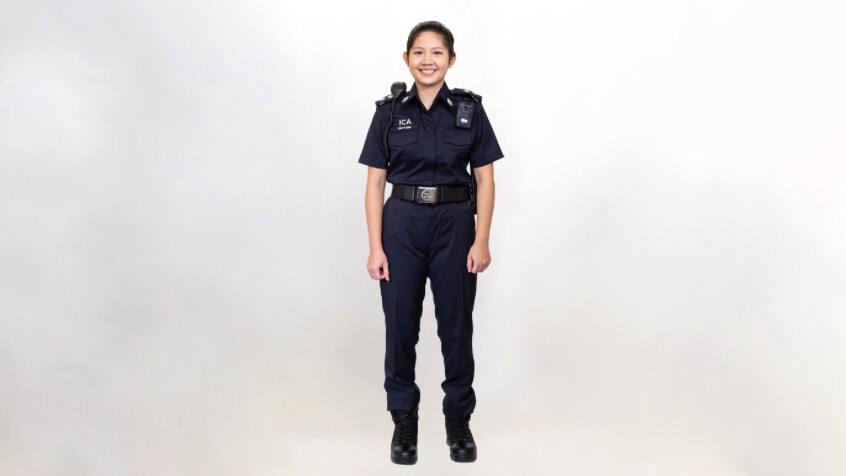
2023 Immigration & Checkpoints Authority No.4 uniform (female)
The new No. 4 uniform has been implemented progressively for frontline officers. The design of the new uniform focused on building a stronger ICA identity, allowing frontline officers to maintain a professional image when performing their duties, and retaining comfort whilst donning operational equipment.
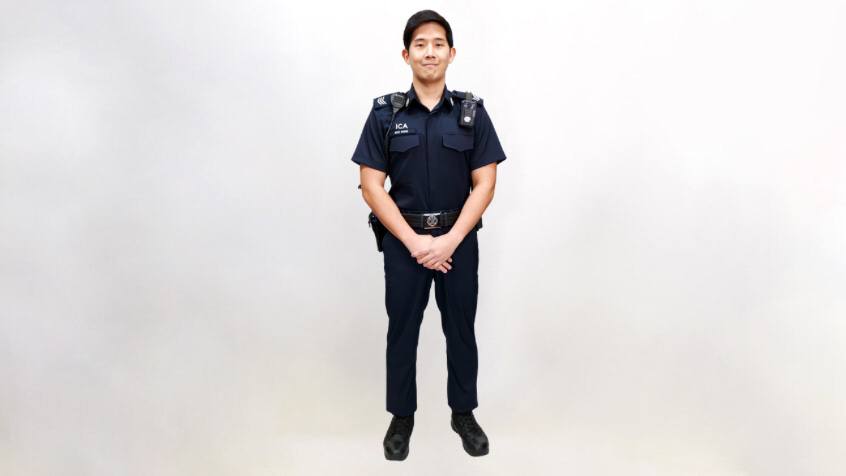
2023 Immigration & Checkpoints Authority No.4 uniform (male)
The new No. 4 uniform has been implemented progressively for frontline officers. The design of the new uniform focused on building a stronger ICA identity, allowing frontline officers to maintain a professional image when performing their duties, and retaining comfort whilst donning operational equipment.
Training Our Officers
2004
2006
2009
2010
2012
2015
2017
Present
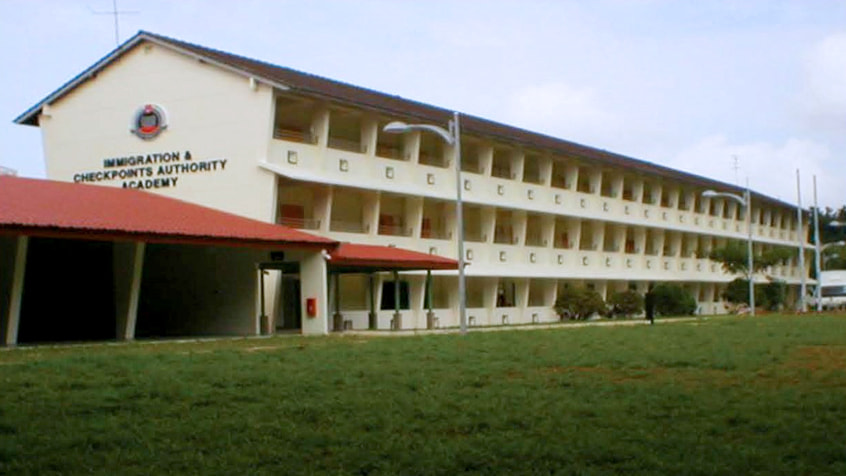
2004: ICA Academy
The ICA Academy was the first training infrastructure established in 2004 to cater to greater demands of training for ICA officers. It was housed in the converted school blocks of the former Jervois Primary School (defunct in 1989) and equipped with facilities conducive for team-building and innovative thinking.
The ICA Academy was the first training infrastructure established in 2004 to cater to greater demands of training for ICA officers. It was housed in the converted school blocks of the former Jervois Primary School (defunct in 1989) and equipped with facilities conducive for team-building and innovative thinking.
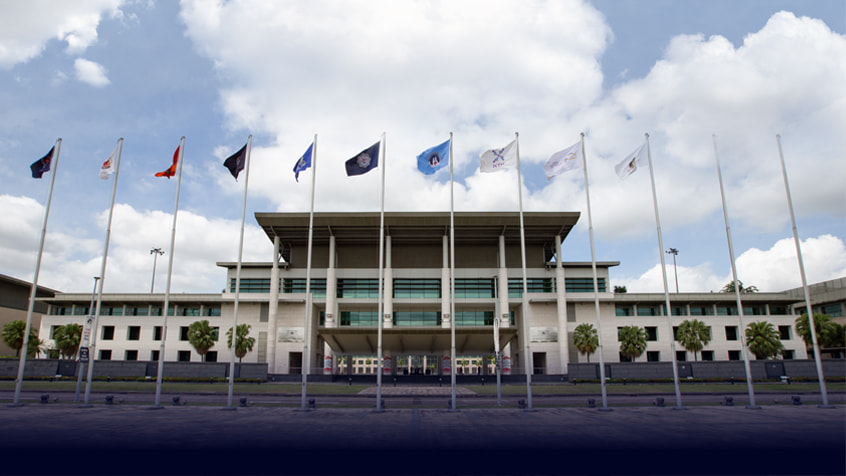
2006: Home Team Academy
In line with the Ministry’s plans for all Home Team training activities to be co-located, training activities were relocated to the Home Team Academy at Old Choa Chu Kang Road in 2006. Here, training philosophies across all Home Team agencies were synergised.
In line with the Ministry’s plans for all Home Team training activities to be co-located, training activities were relocated to the Home Team Academy at Old Choa Chu Kang Road in 2006. Here, training philosophies across all Home Team agencies were synergised.
_1.jpg?sfvrsn=9887c63e_2)
2009: Checkpoint Security Training Suite (CSTS)
In June 2009, ICA took a further leap in its learning capabilities when it moved on to experiential learning, concentrating on the acquisition of skills and enhancement of abilities. The experiential training opportunities, which were available in CSTS, complemented the traditional classroom and theoretical training.
In June 2009, ICA took a further leap in its learning capabilities when it moved on to experiential learning, concentrating on the acquisition of skills and enhancement of abilities. The experiential training opportunities, which were available in CSTS, complemented the traditional classroom and theoretical training.
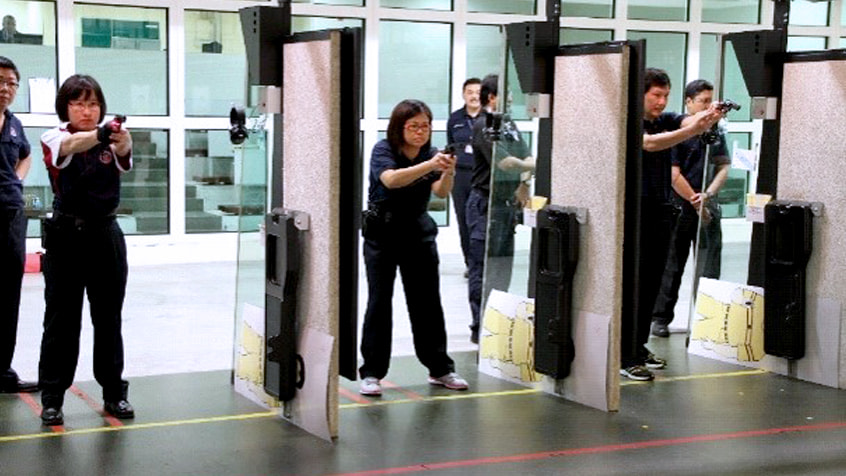
2010: ICA Firearms Training Unit
Did you know that the ICA has its own Firearms Training unit? In the past, all instructions and training related to firearms were provided by the Singapore Police Force or the Auxillary Police Force, but with the setup of the unit, ICA’s homegrown firearms trainers have been overseeing the delivery of the Basic Forearms Training Course for all ICA officers.
Did you know that the ICA has its own Firearms Training unit? In the past, all instructions and training related to firearms were provided by the Singapore Police Force or the Auxillary Police Force, but with the setup of the unit, ICA’s homegrown firearms trainers have been overseeing the delivery of the Basic Forearms Training Course for all ICA officers.
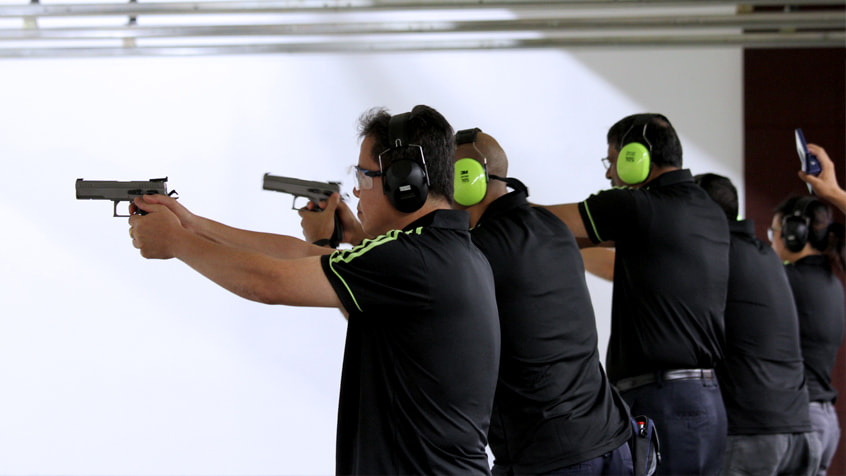
2010: ICA Firearms Training Unit
Did you know that the ICA has its own Firearms Training unit? In the past, all instructions and training related to firearms were provided by the Singapore Police Force or the Auxillary Police Force, but with the setup of the unit, ICA’s homegrown firearms trainers have been overseeing the delivery of the Basic Forearms Training Course for all ICA officers.
Did you know that the ICA has its own Firearms Training unit? In the past, all instructions and training related to firearms were provided by the Singapore Police Force or the Auxillary Police Force, but with the setup of the unit, ICA’s homegrown firearms trainers have been overseeing the delivery of the Basic Forearms Training Course for all ICA officers.
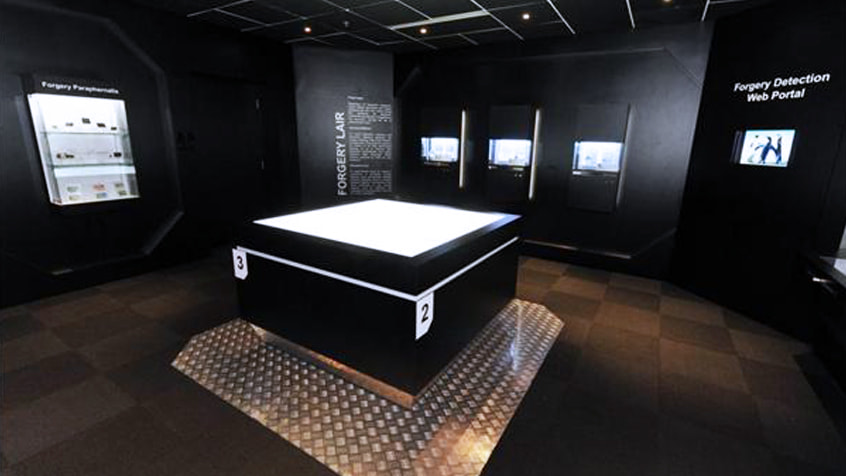
2012: IADA Forensic Document Gallery
Formerly known as IADA Gallery, it was first set up in 2008 as a one-stop learning centre on forgery detection and document examination. To provide a comprehensive learning experience, the gallery was expanded and renamed the IADA Forensic Document Gallery on 30 March comprising of two sections -- the Authentic Room and the Forgery Lair.
Formerly known as IADA Gallery, it was first set up in 2008 as a one-stop learning centre on forgery detection and document examination. To provide a comprehensive learning experience, the gallery was expanded and renamed the IADA Forensic Document Gallery on 30 March comprising of two sections -- the Authentic Room and the Forgery Lair.
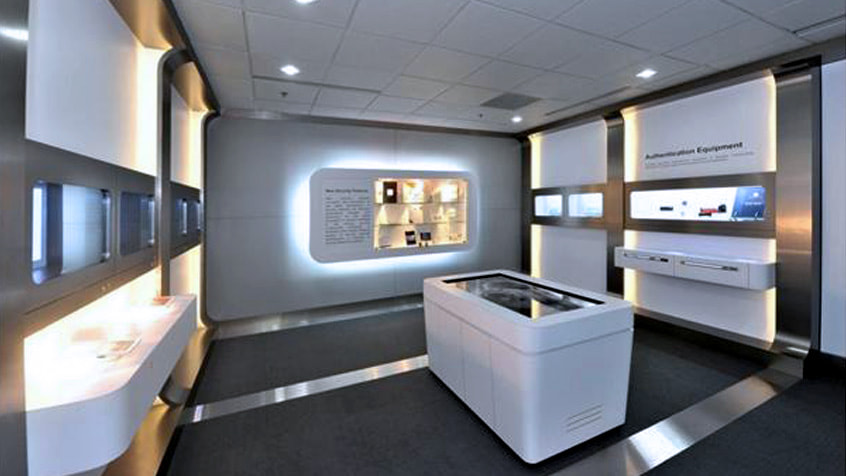
2012: IADA Forensic Document Gallery
Formerly known as IADA Gallery, it was first set up in 2008 as a one-stop learning centre on forgery detection and document examination. To provide a comprehensive learning experience, the gallery was expanded and renamed the IADA Forensic Document Gallery on 30 March comprising of two sections -- the Authentic Room and the Forgery Lair.
Formerly known as IADA Gallery, it was first set up in 2008 as a one-stop learning centre on forgery detection and document examination. To provide a comprehensive learning experience, the gallery was expanded and renamed the IADA Forensic Document Gallery on 30 March comprising of two sections -- the Authentic Room and the Forgery Lair.
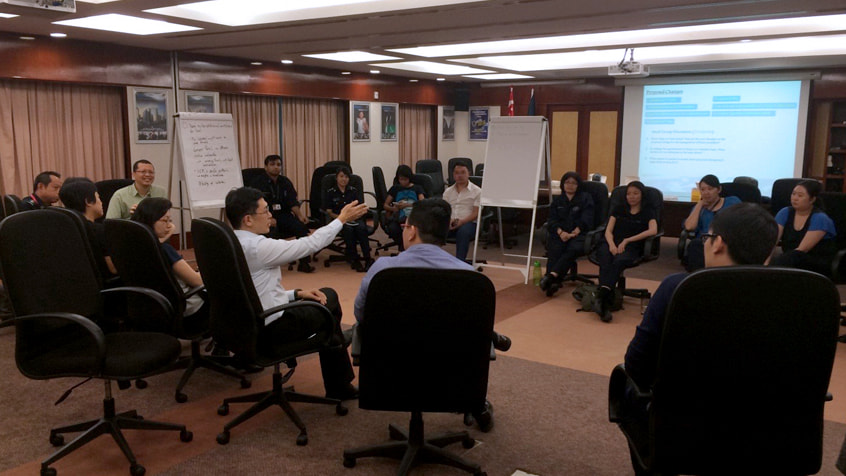
2015: ICA Psychological Services Branch
The Police Psychological Services Division had been supporting the mental health and resilience needs of ICA officers since 2004. With ICA’s development over the years, there was a greater need for an in-house support and service, leading to the formation of the ICA Psychological Services Branch in 2015, providing mental resilience training resources and psychological services for ICA officers.
The Police Psychological Services Division had been supporting the mental health and resilience needs of ICA officers since 2004. With ICA’s development over the years, there was a greater need for an in-house support and service, leading to the formation of the ICA Psychological Services Branch in 2015, providing mental resilience training resources and psychological services for ICA officers.
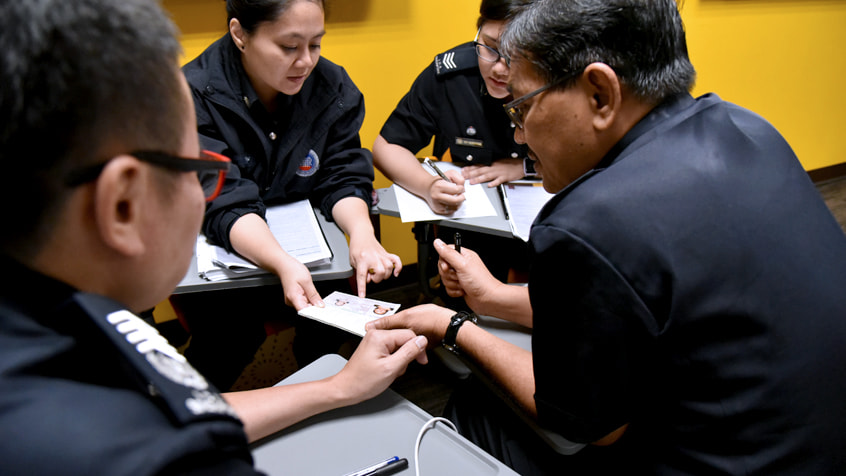
2017: ICA Training Command
As part of Home Team Transformation 2025 and ICA's Transformation journey, ICA Training School was reorganised to the current ICA Training Command. The reorganisation served to enhance ICA's training and learning philosophy, framed by guiding principles that are also aligned to those of the Home Team Academy.
As part of Home Team Transformation 2025 and ICA's Transformation journey, ICA Training School was reorganised to the current ICA Training Command. The reorganisation served to enhance ICA's training and learning philosophy, framed by guiding principles that are also aligned to those of the Home Team Academy.
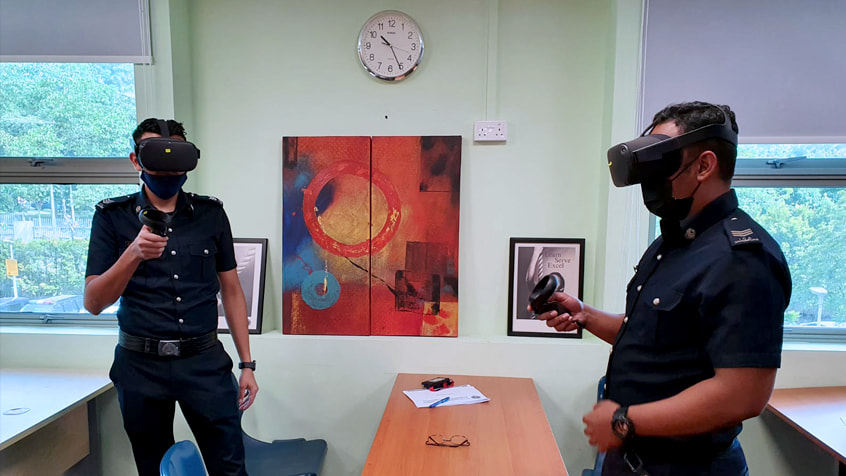
Present: ICA Workforce 2025
To ready our officers for transformed job roles at both the checkpoints and the integrated services centre, ICA aims to train 4,800 officers by 2023. Training spaces had been developed at the domains for accessibility and officers are empowered with self-directed learning.
To ready our officers for transformed job roles at both the checkpoints and the integrated services centre, ICA aims to train 4,800 officers by 2023. Training spaces had been developed at the domains for accessibility and officers are empowered with self-directed learning.
Our Job Roles
A&I Officer
Cargo Clearance Officer
First Response Team Officer
ICA Services Centre Officer
Team Leader
Investigation Officer
Task Force Officer
Image Analyst
SSM Officer
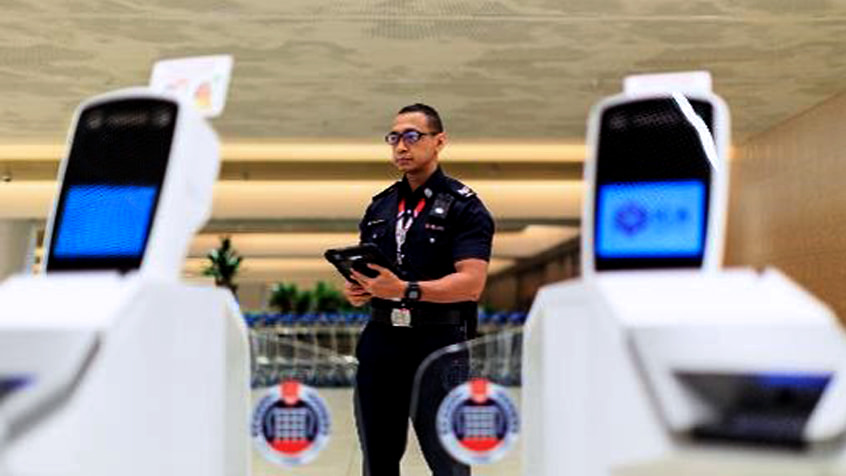
Assessment & Investigation (A&I) Officer
ICA will gradually replace all manual clearance counters with automated lanes to allow for a secured yet seamless clearance experience.
ICA officers will transit from static counter deployment to undertake mobile deployment.
The future A&I Officer will manage a wider area of automated clearance operations while ensuring the legitimate movement of travellers through the checkpoint.
Key Job Roles of an A&I Officer:
ICA will gradually replace all manual clearance counters with automated lanes to allow for a secured yet seamless clearance experience.
ICA officers will transit from static counter deployment to undertake mobile deployment.
The future A&I Officer will manage a wider area of automated clearance operations while ensuring the legitimate movement of travellers through the checkpoint.
Key Job Roles of an A&I Officer:
- Oversees the end-to-end operations at automated lanes
- Conducts interviews and real-time assessment of travellers
- Carries out real-time profiling to sieve out dubious characters for further checks
- Manages security incidents within their area.
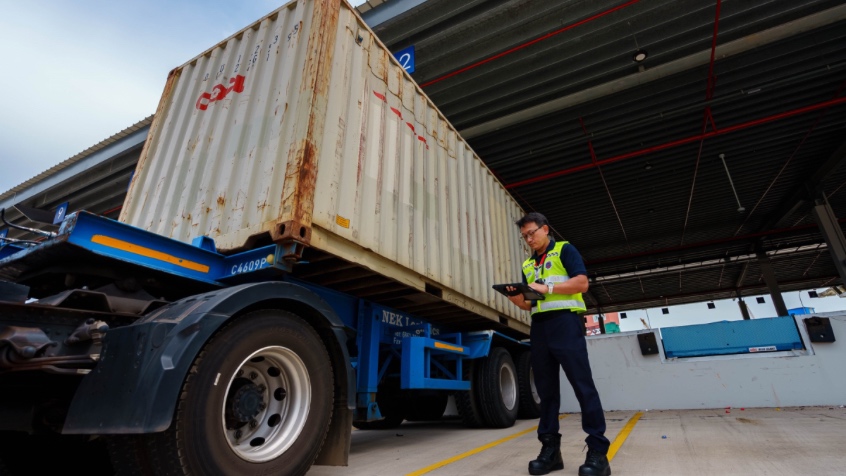
Cargo Clearance Officer
Under NCC, cargo clearance will be more seamless with the transition to paperless clearance, automating cargo processes, and strengthening of detection capabilities.
The transformation of processes will allow ICA to redeploy our officers to take on higher value tasks such as image analysis and cargo profiling.
Key Job Roles of a Cargo Clearance Officer:
Under NCC, cargo clearance will be more seamless with the transition to paperless clearance, automating cargo processes, and strengthening of detection capabilities.
The transformation of processes will allow ICA to redeploy our officers to take on higher value tasks such as image analysis and cargo profiling.
Key Job Roles of a Cargo Clearance Officer:
- Screens and performs checks on cargoes for security-sensitive materials and contrabands
- Leverages the mobile Cargo Screening System (Mobile CASS) for greater operational effectiveness to retrieve permit information and conduct permit clearance at mobile locations
- Works closely with relevant controlling agencies for follow-up enforcement action.
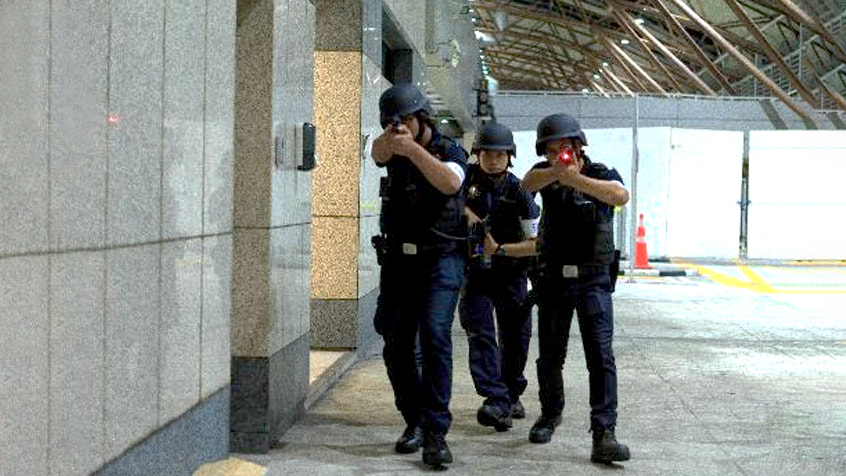
First Response Team Officer
ICA’s role in border security had transformed with the taking over of Protective Security (PS) functions at the land and land-based sea checkpoints.
- First responder to security incidents
- Undertakes protective security duties (e.g., conduct of armed patrols, crowd control duties etc.) in addition to clearance security functions
- Trained in weapons handling, tactical movement, as well as interview and search techniques.
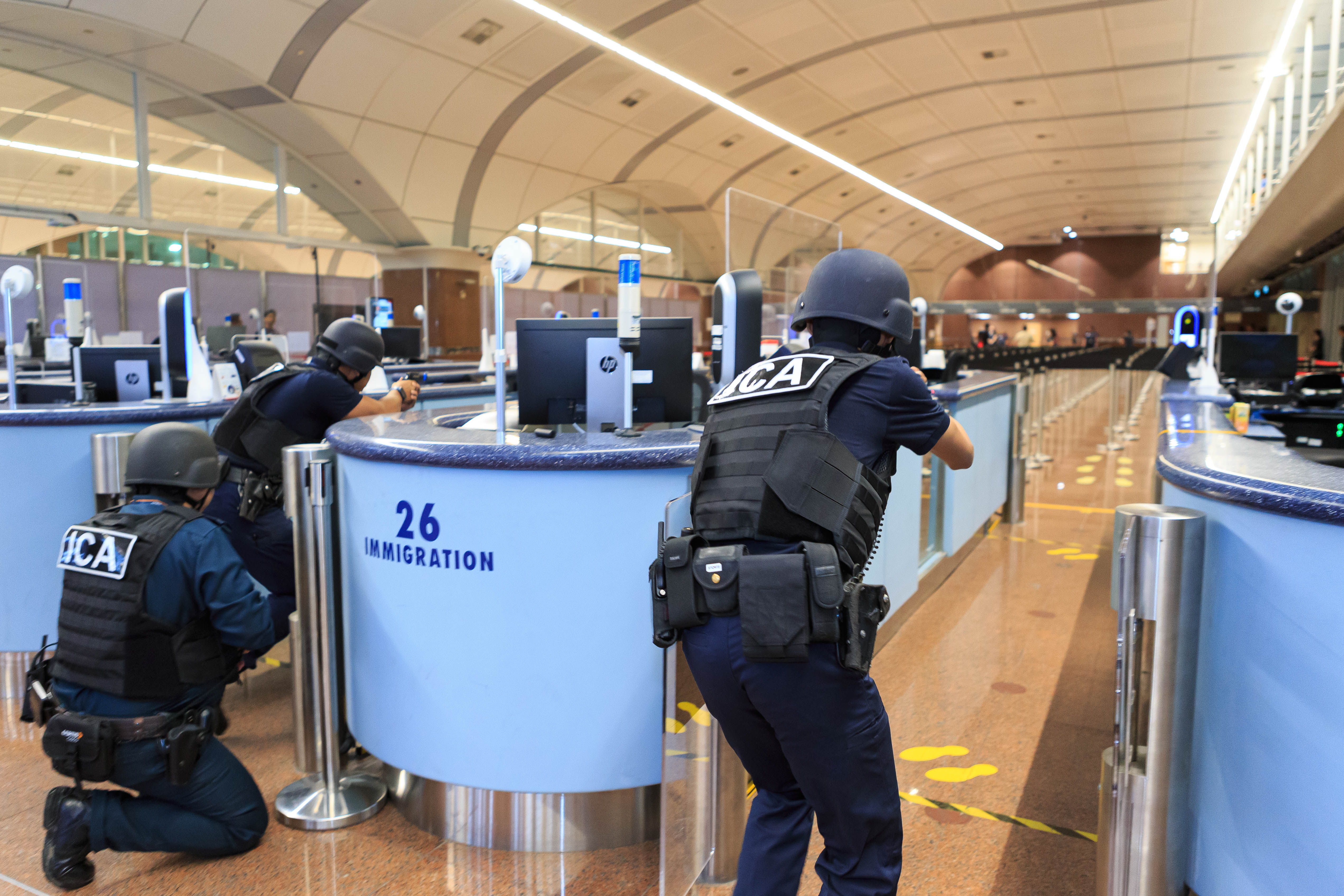
First Response Team Officer
ICA’s role in border security had transformed with the taking over of Protective Security (PS) functions at the land and land-based sea checkpoints.
- First responder to security incidents
- Undertakes protective security duties (e.g., conduct of armed patrols, crowd control duties etc.) in addition to clearance security functions
- Trained in weapons handling, tactical movement, as well as interview and search techniques.
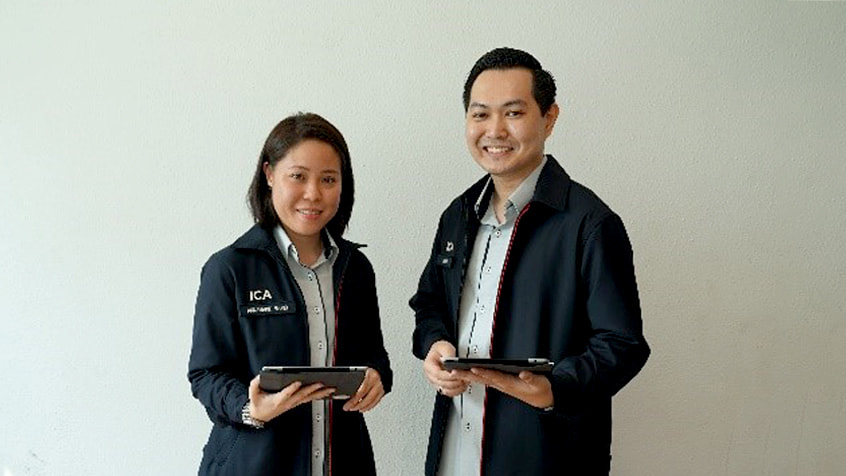
ICA Services Centre Officer
The ICA Services Centre (ISC), which is set to be completed in 2024, will provide:
The ICA Services Centre (ISC), which is set to be completed in 2024, will provide:
- Seamless, one-stop service to members of public;
- Integrated backend processing for holistic assessment of applications; and
- Intelligent robotics technology for the secure transportation of documents.
- Provides effective and efficient customer service relating to all ICA products and services
- Processes applications for Singapore citizenship and immigration facilities such as Permanent Residence, and Long-Term Passes
- Reviews appeals and cases involving a person's immigration status in Singapore such as dual citizenship and revocation of permanent residency.
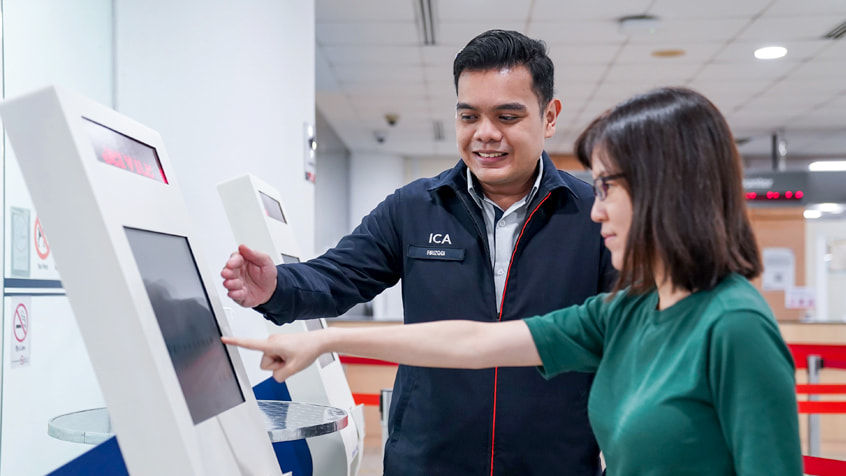
ICA Services Centre Officer
The ICA Services Centre (ISC), which is set to be completed in 2024, will provide:
The ICA Services Centre (ISC), which is set to be completed in 2024, will provide:
- Seamless, one-stop service to members of public;
- Integrated backend processing for holistic assessment of applications; and
- Intelligent robotics technology for the secure transportation of documents.
- Provides effective and efficient customer service relating to all ICA products and services
- Processes applications for Singapore citizenship and immigration facilities such as Permanent Residence, and Long-Term Passes
- Reviews appeals and cases involving a person's immigration status in Singapore such as dual citizenship and revocation of permanent residency.
Team Leader
A Team Leader is responsible for the implementation and enforcement of laws, regulations and policies of the various work of ICA, as well as the management and operation of the various branches/commands under ICA.
Leading a team of highly-skilled and well-trained ICA officers who are tasked with the duty of protecting Singapore's gateways, the Team Leader plays a critical role in ensuring the security of the nation. The Team Leader should possess leadership capability, be decisive, mentally agile, and display qualities of courage and integrity.
A Team Leader is responsible for the implementation and enforcement of laws, regulations and policies of the various work of ICA, as well as the management and operation of the various branches/commands under ICA.
Leading a team of highly-skilled and well-trained ICA officers who are tasked with the duty of protecting Singapore's gateways, the Team Leader plays a critical role in ensuring the security of the nation. The Team Leader should possess leadership capability, be decisive, mentally agile, and display qualities of courage and integrity.
Team Leader
A Team Leader is responsible for the implementation and enforcement of laws, regulations and policies of the various work of ICA, as well as the management and operation of the various branches/commands under ICA.
Leading a team of highly-skilled and well-trained ICA officers who are tasked with the duty of protecting Singapore's gateways, the Team Leader plays a critical role in ensuring the security of the nation. The Team Leader should possess leadership capability, be decisive, mentally agile, and display qualities of courage and integrity.
A Team Leader is responsible for the implementation and enforcement of laws, regulations and policies of the various work of ICA, as well as the management and operation of the various branches/commands under ICA.
Leading a team of highly-skilled and well-trained ICA officers who are tasked with the duty of protecting Singapore's gateways, the Team Leader plays a critical role in ensuring the security of the nation. The Team Leader should possess leadership capability, be decisive, mentally agile, and display qualities of courage and integrity.
Investigation Officer
Investigation officers (IOs) investigate offences related to the Immigration Act, Passports Act, and the National Registration Act. ICA investigates common offences such as illegal immigrants, overstayers, harbouring and employment of immigration offenders, human smuggling, possession of forged passports as well as marriages of convenience.
IOs must have a thirst for truth and should be one who loves to pursue justice until it is served.
Investigation officers (IOs) investigate offences related to the Immigration Act, Passports Act, and the National Registration Act. ICA investigates common offences such as illegal immigrants, overstayers, harbouring and employment of immigration offenders, human smuggling, possession of forged passports as well as marriages of convenience.
IOs must have a thirst for truth and should be one who loves to pursue justice until it is served.
Investigation Officer
Investigation officers (IOs) investigate offences related to the Immigration Act, Passports Act, and the National Registration Act. ICA investigates common offences such as illegal immigrants, overstayers, harbouring and employment of immigration offenders, human smuggling, possession of forged passports as well as marriages of convenience.
IOs must have a thirst for truth and should be one who loves to pursue justice until it is served.
Investigation officers (IOs) investigate offences related to the Immigration Act, Passports Act, and the National Registration Act. ICA investigates common offences such as illegal immigrants, overstayers, harbouring and employment of immigration offenders, human smuggling, possession of forged passports as well as marriages of convenience.
IOs must have a thirst for truth and should be one who loves to pursue justice until it is served.
Task Force Officer
The role of each Task Force officer (TFO) is to concentrate on profiling persons and conveyances with the intention of detecting the smuggling of humans and contraband, and to gather intelligence at the checkpoint for analysis and future profiling.
The TFO should enjoy being challenged every day, be observant and agile enough to uncover security threats daily.
The role of each Task Force officer (TFO) is to concentrate on profiling persons and conveyances with the intention of detecting the smuggling of humans and contraband, and to gather intelligence at the checkpoint for analysis and future profiling.
The TFO should enjoy being challenged every day, be observant and agile enough to uncover security threats daily.
Task Force Officer
The role of each Task Force officer (TFO) is to concentrate on profiling persons and conveyances with the intention of detecting the smuggling of humans and contraband, and to gather intelligence at the checkpoint for analysis and future profiling.
The TFO should enjoy being challenged every day, be observant and agile enough to uncover security threats daily.
The role of each Task Force officer (TFO) is to concentrate on profiling persons and conveyances with the intention of detecting the smuggling of humans and contraband, and to gather intelligence at the checkpoint for analysis and future profiling.
The TFO should enjoy being challenged every day, be observant and agile enough to uncover security threats daily.
Image Analyst
Image analysts are constantly on the lookout for anomalies in cargo. They watch out for any irregular shapes that should not be present in the scanned containers.
A radio image analyst should possess a keen eye for detail and be shrewd enough to uncover what lies beneath the surface.
Image analysts are constantly on the lookout for anomalies in cargo. They watch out for any irregular shapes that should not be present in the scanned containers.
A radio image analyst should possess a keen eye for detail and be shrewd enough to uncover what lies beneath the surface.
Security Sensitive Materials (SSM) Officer
ICA Security Sensitive Materials (SSM) officer are carefully selected based on their work performance, attitude and aptitude towards science and technology. Leveraging on their operational experience and skills, ICA SSM officers will select and draw samples of suspicious goods and conveyances and assist HTX in conducting CBRE (Chemical, Biological, Radiological, Explosive) analysis.
An SSM officer would have the penchant for science and look forward to a different experience every day. They would also be meticulous and like to leave no stone unturned.
ICA Security Sensitive Materials (SSM) officer are carefully selected based on their work performance, attitude and aptitude towards science and technology. Leveraging on their operational experience and skills, ICA SSM officers will select and draw samples of suspicious goods and conveyances and assist HTX in conducting CBRE (Chemical, Biological, Radiological, Explosive) analysis.
An SSM officer would have the penchant for science and look forward to a different experience every day. They would also be meticulous and like to leave no stone unturned.
Security Sensitive Materials (SSM) Officer
ICA Security Sensitive Materials (SSM) officer are carefully selected based on their work performance, attitude and aptitude towards science and technology. Leveraging on their operational experience and skills, ICA SSM officers will select and draw samples of suspicious goods and conveyances and assist HTX in conducting CBRE (Chemical, Biological, Radiological, Explosive) analysis.
An SSM officer would have the penchant for science and look forward to a different experience every day. They would also be meticulous and like to leave no stone unturned.
ICA Security Sensitive Materials (SSM) officer are carefully selected based on their work performance, attitude and aptitude towards science and technology. Leveraging on their operational experience and skills, ICA SSM officers will select and draw samples of suspicious goods and conveyances and assist HTX in conducting CBRE (Chemical, Biological, Radiological, Explosive) analysis.
An SSM officer would have the penchant for science and look forward to a different experience every day. They would also be meticulous and like to leave no stone unturned.
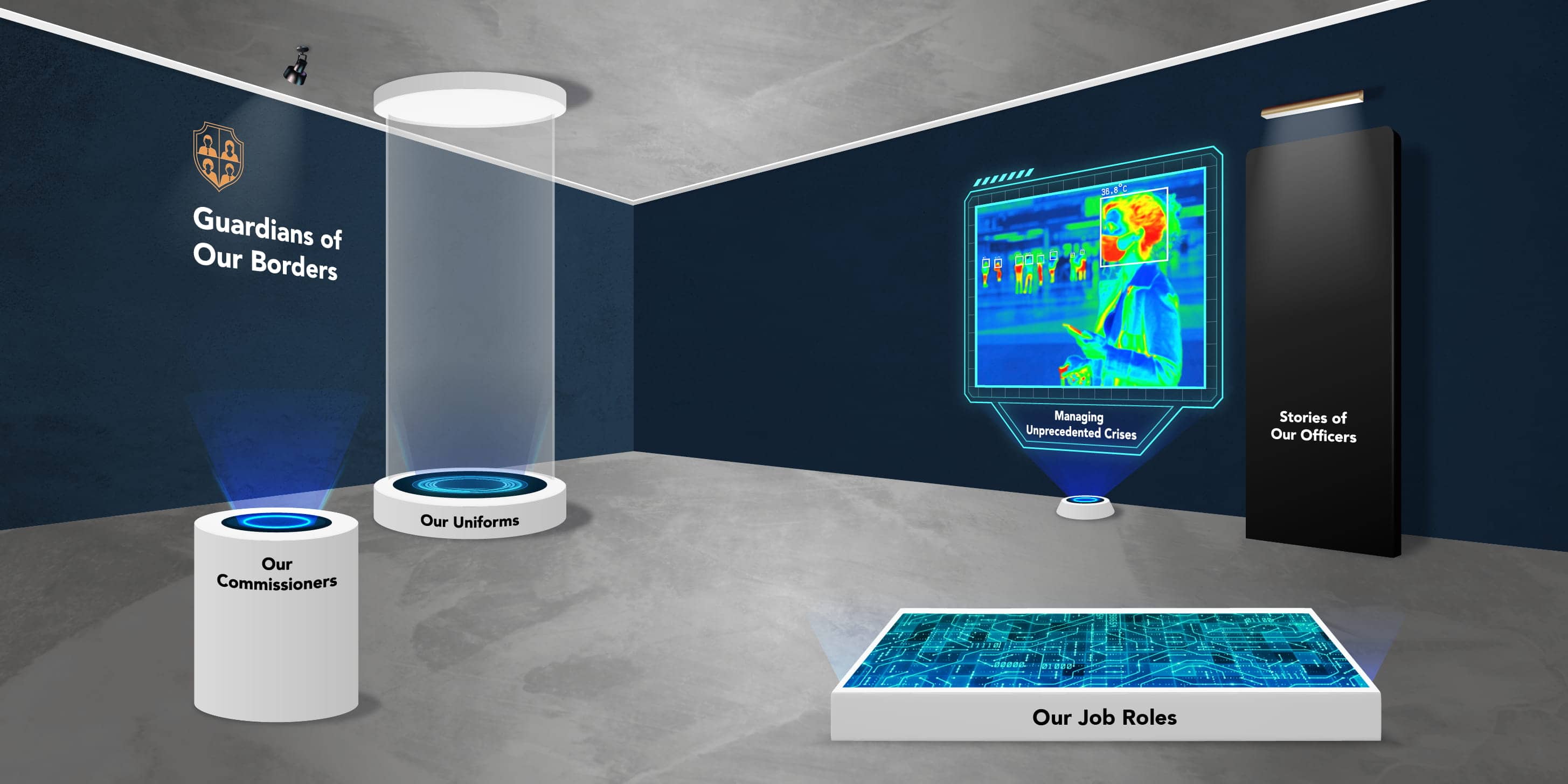
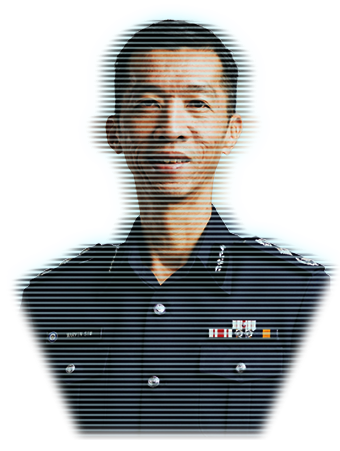
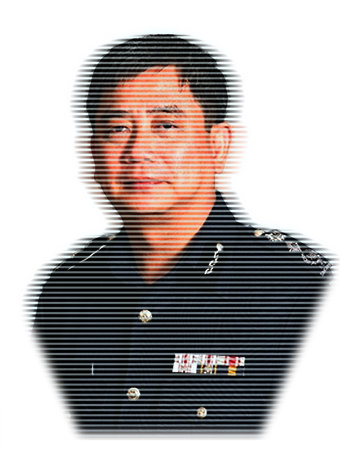
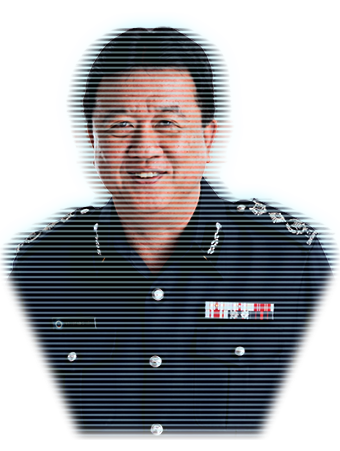
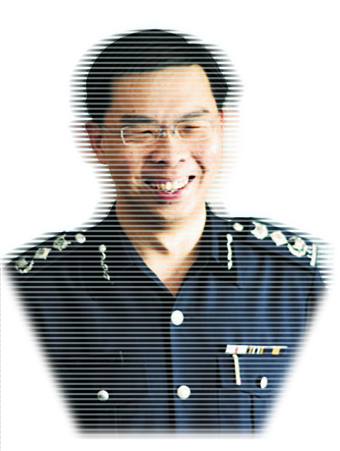

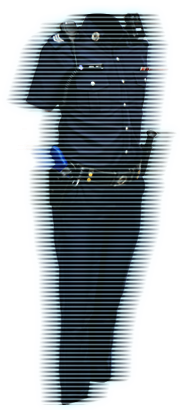








-mohamed-ismail-ameer-batcha.png?sfvrsn=c2d29e44_2)
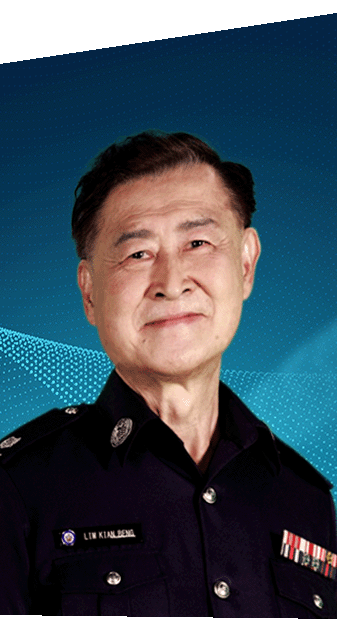
-quek-kian-beng.png?sfvrsn=edb0af72_2)
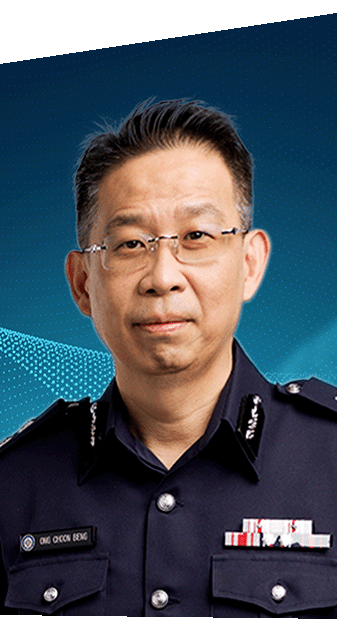
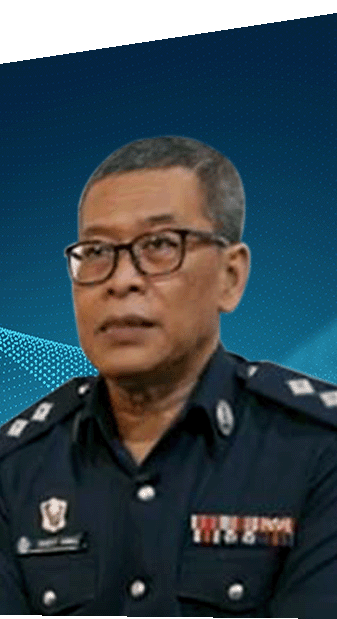
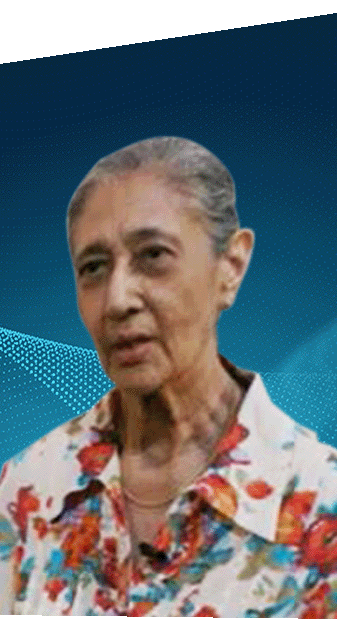
.png?sfvrsn=10e06b46_2)
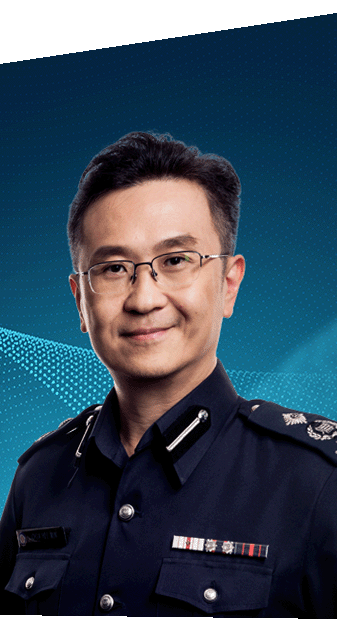
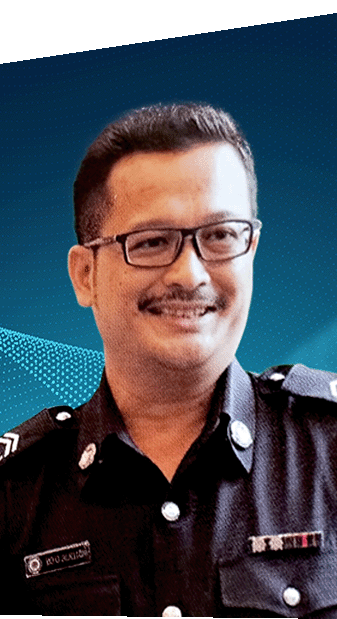
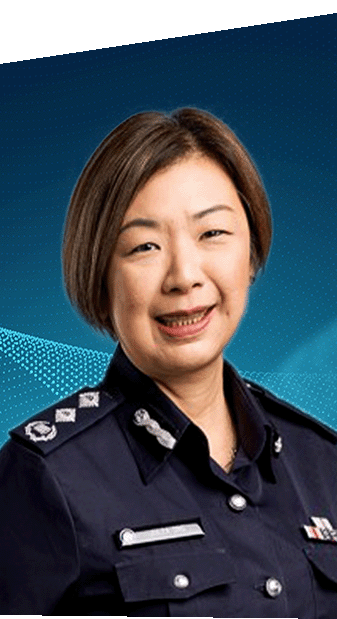
-mohd-anwar-bin-abdullah-@-teo-ah-hock.png?sfvrsn=ef10f1b7_2)
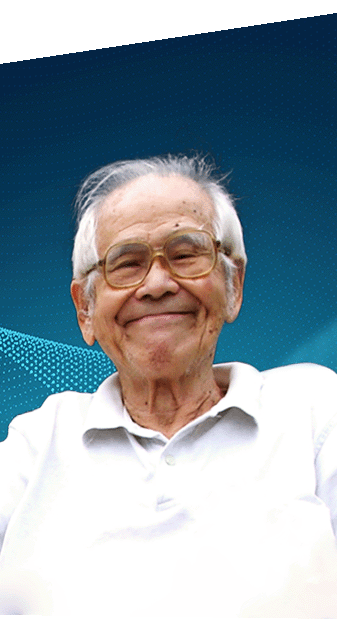

.png?sfvrsn=edd99933_2)
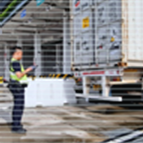
.png?sfvrsn=104e01f0_4)
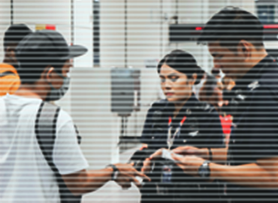
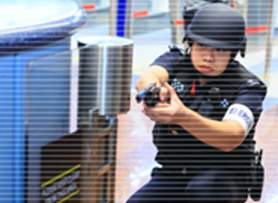

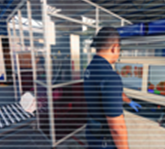

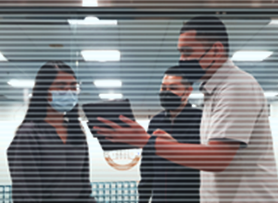
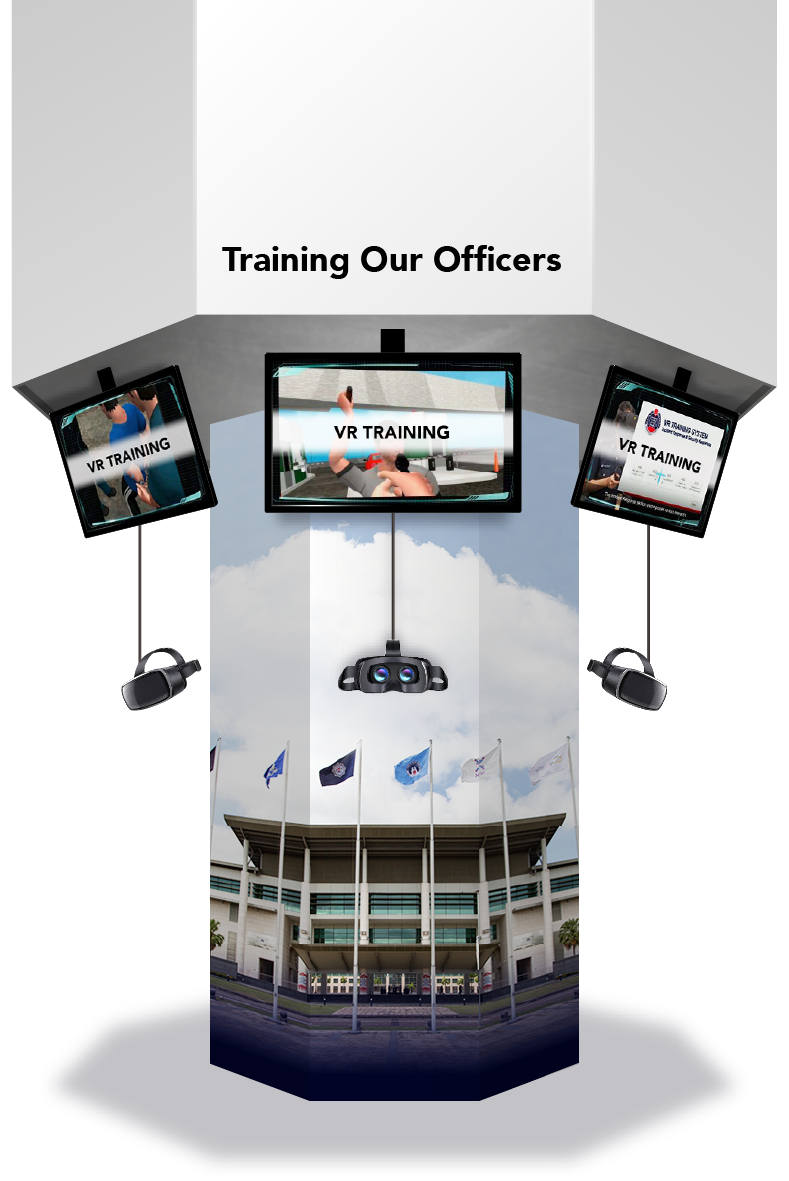









Share this link via